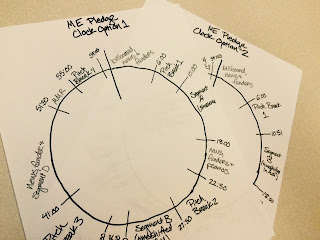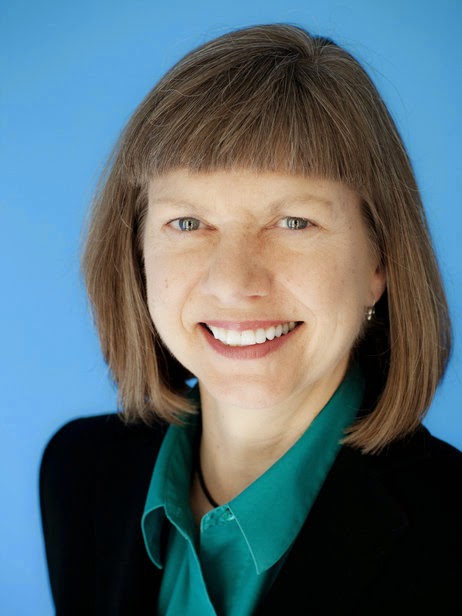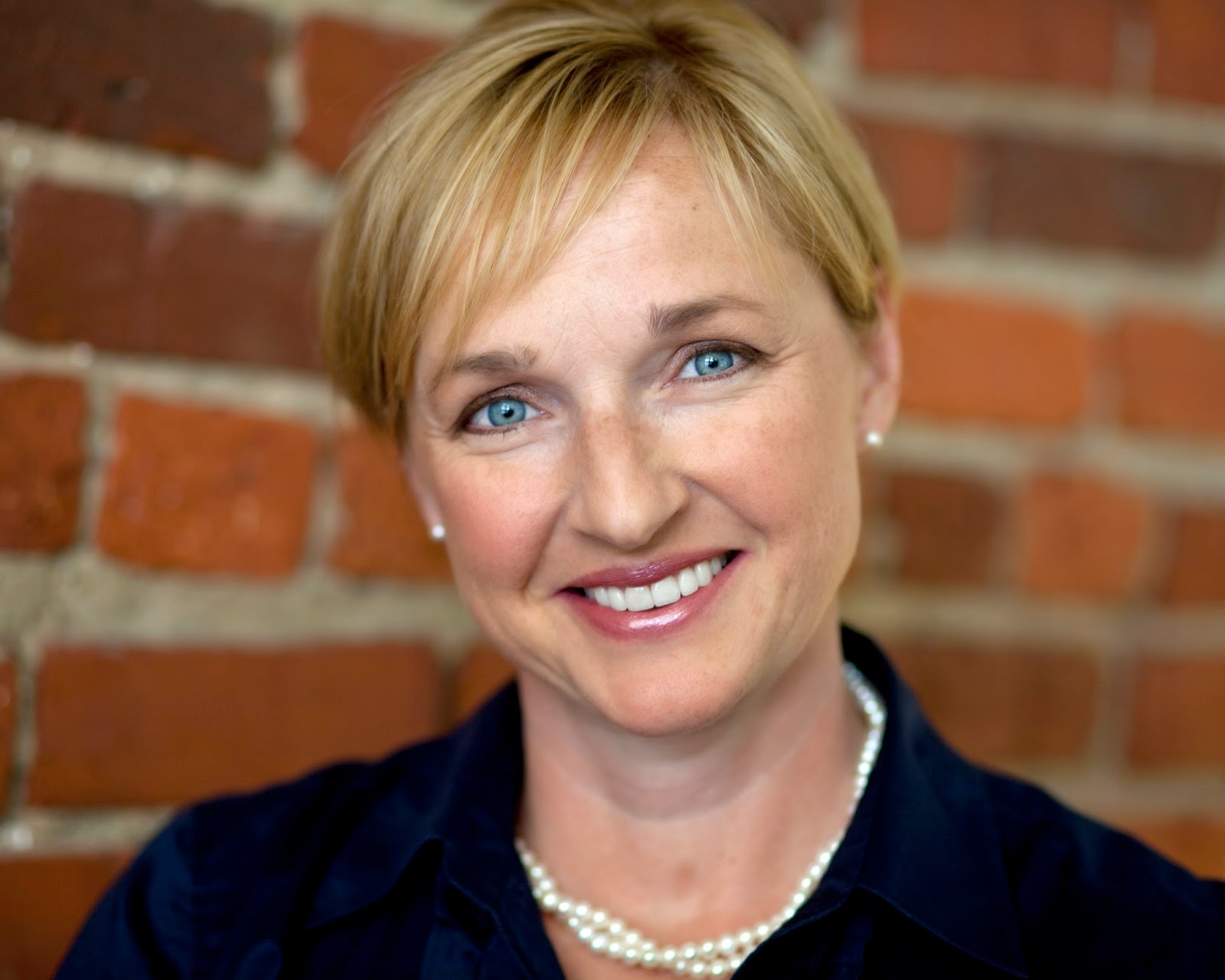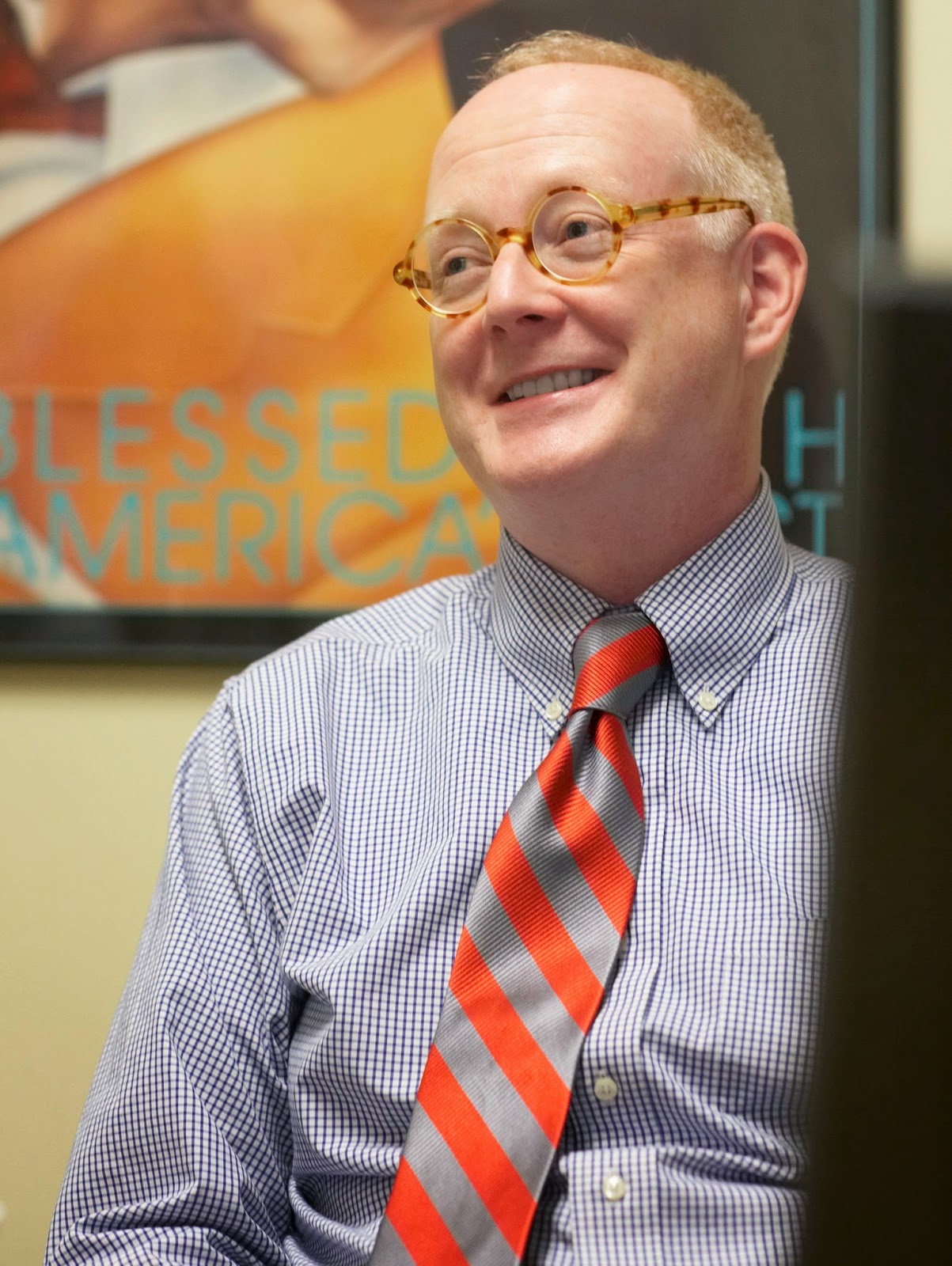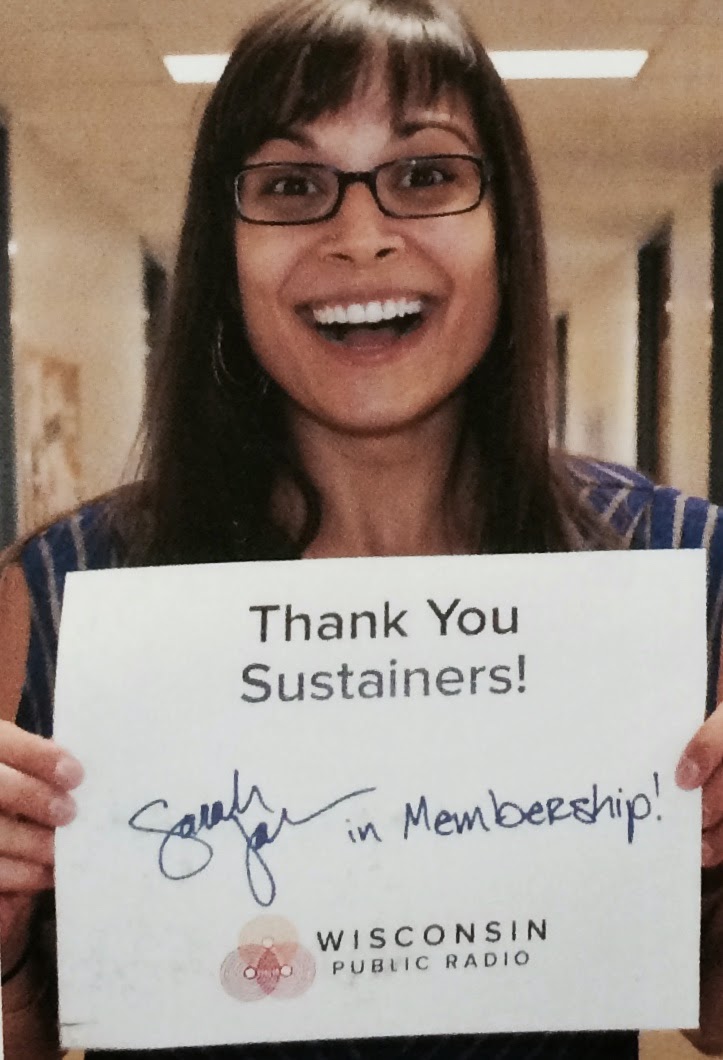All posts by media-man
Law for Media Startups – New Entrepreneurship Guide
Posted To: Press Releases
|
For immediate release Noon, March. 4, 2015 |
Contact: Jan Schaffer jans@j-lab.org |
J-Lab partners with CUNY to create e-guide
Washington, D.C.– “Law for Media Startups,” a new resource for entrepreneurs launching news ventures and educators teaching students how to do it, was published today by CUNY’s Tow-Knight Center for Entrepreneurial Journalism.
The 12-chapter web guide was written by Jan Schaffer, J-Lab executive director, and Jeff Kosseff, media lawyer for Covington & Burling LLP law firm in Washington, D.C. The Tow-Knight Center supported the research, writing and production as part of its suite of entrepreneurial journalism resources.
“This guide goes beyond traditional First Amendment law to address every-day issues news entrepreneurs confront,” Schaffer said. “From native advertising to labor law and fair use, it supplies what I found missing for my students.”
"Every day, innovators are developing new ways to deliver news and content to consumers," Kosseff said. "I hope this guide helps them identify the legal issues that they should be considering as they build their business models."
Small digital news startups are facing a range of legal issues as they set up their business operations, gather and report the news, protect their content, and market and support their news ventures. They need to know classic First Amendment law – and much more. This guide offers an introduction to many of those issues, from hiring freelancers and establishing organizational structures, to native advertising and marketing, to maintaining privacy policies and dealing with libel accusations. It seeks to help jumpstart the launch of news ventures and help entrepreneurs know when to seek professional legal help.
“The news ecosystem of the future will be made up of enterprises of many sizes, shapes, and forms, including journalistic startups that need help with their businesses and the law” said Jeff Jarvis, Director of the Tow-Knight Center. “Jan Schaffer and Jeff Kosseff provide an invaluable guide to help them recognize legal pitfalls. It complements other research from Tow-Knight on a variety of business practices.”
Jeff Kosseff is a communications and privacy attorney in Covington & Burling’s Washington, D.C. office, where he represents and advises media and technology companies. He is co-chair of the Media Law Resource Center’s legislative affairs committee. He clerked for Judge Milan D. Smith, Jr. of the U.S. Court of Appeals for the Ninth Circuit and Judge Leonie M. Brinkema of the U.S. District Court for the Eastern District of Virginia. He is an adjunct professor of communications law at American University, where he teaches in its MA in Media Entrepreneurship program. Before becoming a lawyer, Kosseff was a journalist for The Oregonian and was a finalist for the Pulitzer Prize and recipient of the George Polk Award for national reporting.
Jan Schaffer is executive director of J-Lab, an incubator for news entrepreneurs and innovators, and Entrepreneur in Residence at American University’s School of Communication, where she also teaches in its MA in Media Entrepreneurship program. She launched J-Lab in 2002 to help newsrooms use digital technologies to engage people in public issues. It has funded 100 news startups and pilot collaboration projects and it has commissioned and developed a series of online journalism resources that include Launching a Nonprofit News Site, Top Ten Rules for Limited Legal Risk and The Journalist’s Guide to Open Government. As the federal court reporter for The Philadelphia Inquirer, she was part of a team awarded the Pulitzer Gold Medal for Public Service for a series of stories that won freedom for a man wrongly convicted of five murders and led to the civil rights convictions of six Philadelphia homicide detectives.
The “Law for Media Startups” guide also invites media lawyers around the country to contribute information on state-specific laws that apply to news entrepreneurs, following the guide’s template for laws in Virginia.
J-Lab is a journalism catalyst that has provided funding and resources for news startups. It has funded 100 startups and pilot projects since 2005.
The Tow-Knight Center for Entrepreneurial Journalism offers educational programs, supports research, and sponsors events to foster sustainable business models for quality journalism. It is part of the City University of New York's Graduate School of Journalism, and funded by The Tow Foundation and The Knight Foundation.
Switching to OAuth in the App Template
Suyeon Son and David Eads re-worked the authentication mechanism for accessing Google Spreadsheets with the NPR Visuals App Template. This is a significant change for App Template users. Here’s why we did it and how it works.
Most App Template developers only need to consult the Configuring your system and Authenticating sections of this post, provided someone on your team has gone through the process of creating a Google API application and given you credentials.
Why OAuth?
Prior to this change, the App Template accessed Google spreadsheets with a user account and password. These account details were accessed from environment variables stored in cleartext. Storing a password in cleartext is a bad security practice, and the method led to other dubious practices like sharing credentials for a common Google account.
OAuth is a protocol for accessing online resources on behalf of a user without a password. The user must authenticate with the service using her password to allow the app to act on her behalf. In turn the app receives a magic access token. Instead of directly authenticating the user with the service, the application uses the token to access resources.
There are many advantages to this approach. These access tokens can be revoked or invalidated. If used properly, OAuth credentials are always tied to an individual user account. An application can force all users to re-authenticate by resetting the application credentials. Accessing Google Drive resources with this method is also quite a bit faster than our previous technique.
Setting up the Google API application
To use the new OAuth feature of the App Template, you will need to create a Google API project and generate credentials. Typically, you’ll only need to do this once for your entire organization.
Visit the Google Developer’s Console and click “Create Project”.

Give the project a name for the API dashboard and wait for the project to be created:
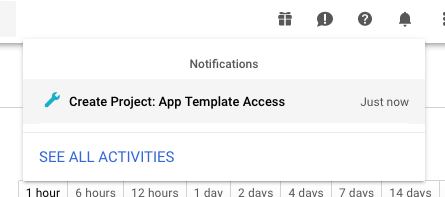
Give the project a name again (oh, technology!) by clicking “Consent screen” in the left hand toolbar:
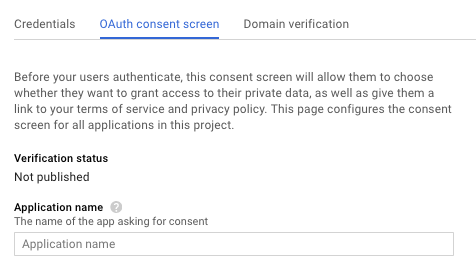
Enable the Drive API by clicking “APIs” in the left hand toolbar, searching for “Drive” and enabling the Drive API:
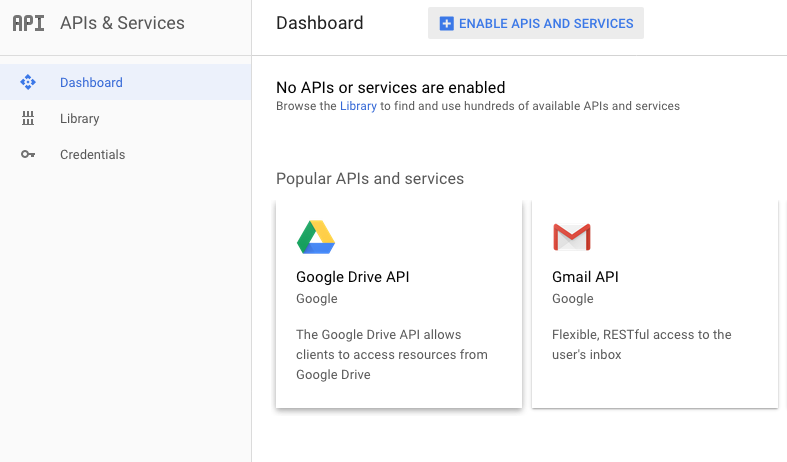
You can optionally disable the default APIs if you’d like.
Finally, create client credentials by clicking “Credentials” in the left hand toolbar and then clicking “Create New Client ID”:

Make sure “Web application” is selected. Set the Javascript origins to “http://localhost:8000”, “http://127.0.0.1:8000”, “http://localhost:8888” and “http://127.0.0.1:8888”. Set the Authorized Redirect URIs to “http://localhost:8000/authenticate/”, “http://127.0.0.1:8000/authenticate/”, “http://localhost:8888/authenticate/” and “http://127.0.0.1:8888”.

Now you have some credentials:
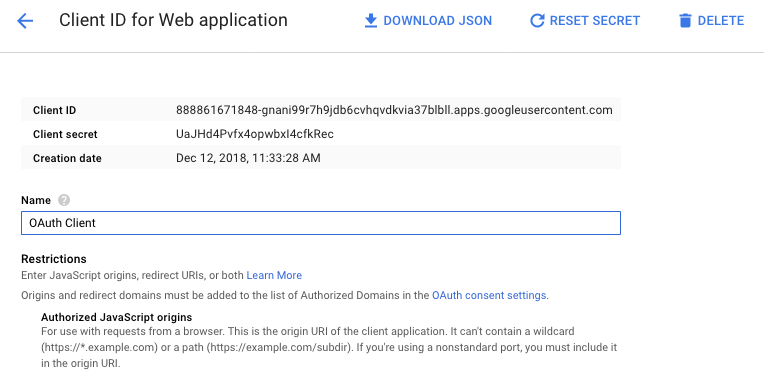
Configuring your system
Whew! Happily, that’s the worst part. Typically, you should only do this once for your whole organization.
Add some environment variables to your .bash_profile or current shell session based on the client ID credentials you created above:
export GOOGLE_OAUTH_CLIENT_ID="825131989533-7kjnu270dqmreatb24evmlh264m8eq87.apps.googleusercontent.com"
export GOOGLE_OAUTH_CONSUMER_SECRET="oy8HFRpHlJ6RUiMxEggpHaTz"
export AUTHOMATIC_SALT="mysecretstring"As you can see above, you also need to set a random string to act as cryptographic salt for the OAuth library the App Template uses.
Authenticating
Now, run fab app in your App Template project and go to localhost:8000 in your web browser. You’ll be asked to allow the application to access Google Drive on behalf of your account:
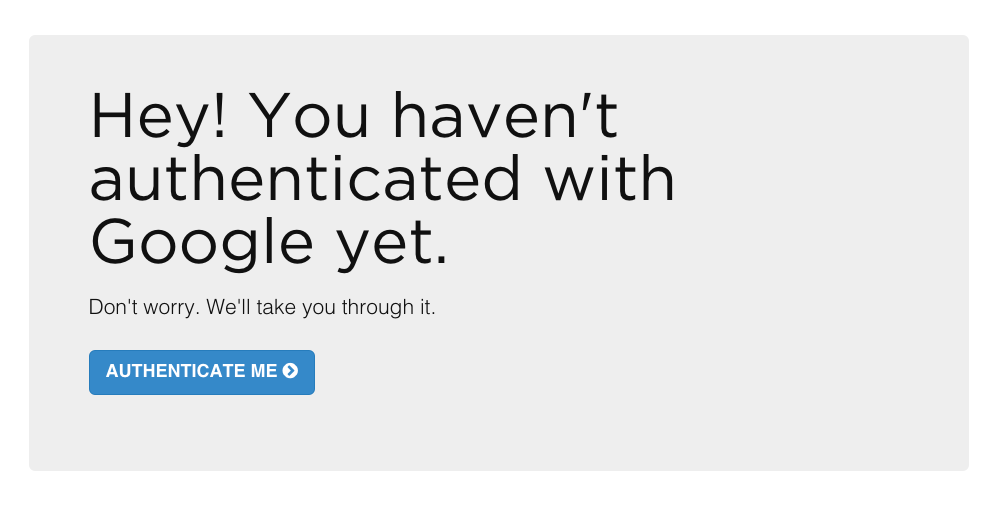
If you use multiple Google accounts, you might need to pick one:
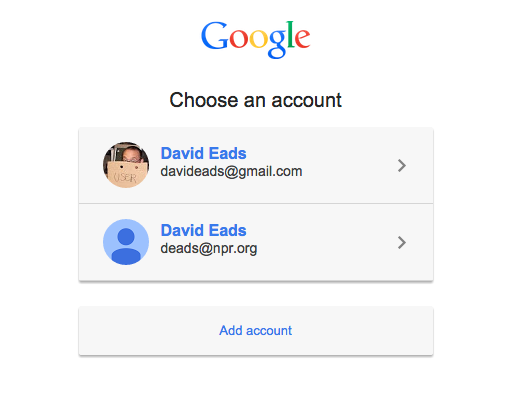
Google would like you to know what you’re getting into:

That’s it. You’re good to go!
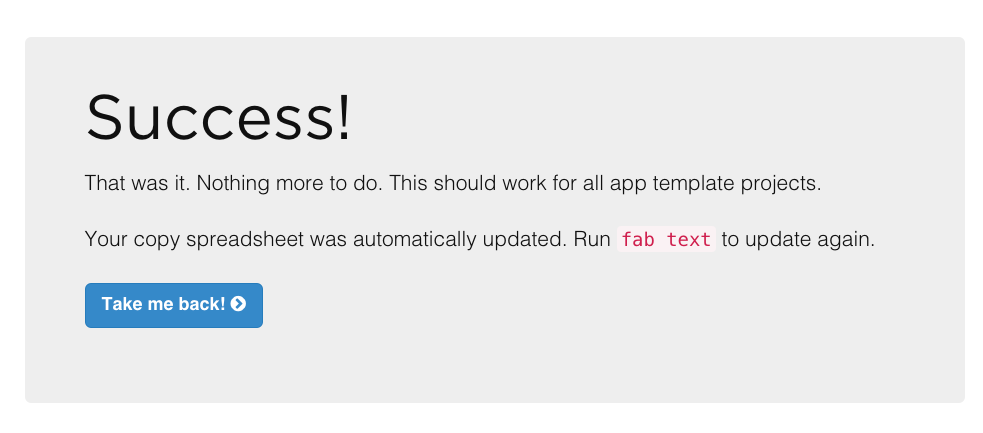
Bonus: Automatically reloading the spreadsheet
Any route decorated with the @oauth_required decorator can be passed a refresh=1 querystring parameter which will force the latest version of the spreadsheet to be downloaded (e.g. localhost:8000/?refresh=1).
This is intended to improve the local development experience when the spreadsheet is in flux.
Behind the scenes
The new system relies on the awesome Authomatic library (developed by a photojournalist!).
We provide a decorator in oauth.py that wraps a route with a check for valid credentials, and re-routes the user through the authentication workflow if the credentials don’t exist.
Here’s an example snippet to show how it works:
from flask import Flask, render_template
from oauth import oauth_required
app = Flask(__name__)
@app.route('/')
@oauth_required
def index():
context = {
‘title’: ‘My awesome project’,
}
return render_template(‘index.html’, **context)Authomatic provides an interface for serializing OAuth credentials. After successfully authenticating, the App Template writes serialized credentials to a file called ~/.google_oauth_credentials and reads them when needed.
By using the so-called “offline access” option, the credentials can live in perpetuity, though the access token will change from time-to-time. Our implementation hides this step in a function called get_credentials which automatically refreshes the credentials if necessary.
By default, credentials are global – once you’re authenticated for one app template project, you’re authenticated for them all. But some projects may require different credentials – perhaps you normally access the project spreadsheet using your USERNAME@YOURORG.ORG account, but for some reason need to access it using your OTHERUSERNAME@GMAIL.COM account. In this case you can specify a different credentials file in app_config.py by changing GOOGLE_OAUTH_CREDENTIALS_PATH:
GOOGLE_OAUTH_CREDENTIALS_PATH = '~/.special_project_credentials'Finally, the Google Doc access mechanism has changed. If you need to access a Google spreadsheet that’s not involved with the default COPY rig, use the new get_document(key, file_path) helper function. The function takes two parameters: a spreadsheet key and path to write the exported Excel file. Here’s an example of what you might do:
from copytext import Copy
from oauth import get_document
def read_my_google_doc():
file_path = 'data/extra_data.xlsx'
get_document('0AlXMOHKxzQVRdHZuX1UycXplRlBfLVB0UVNldHJYZmc', file_path)
data = Copy(file_path)
for row in data['example_list']:
print '%s: %s' % (row['term'], row['definition'])
read_my_google_doc()Multivariate testing: Learning what works from your users at scale
Multivariate and AB testing are generally used to iterate on products over time. But what do you do when your product is always different, like the visual stories we tell?
For the past year, NPR Visuals has been iterating on a story format for picture stories that works like a slideshow, presenting full-width cards with photos, text and any other HTML elements. We have made various tweaks to the presentation, but since each story is substantially different, it’s hard to know definitively what works.
With three stories approaching launch in the middle of February (“A Brother And Sister In Love”, “Life After Death” and “A Photo I Love: Thomas Allen Harris”), we decided to test different ways to get a user to take action at the end of a story. We wanted to encourage users to support NPR or, in the case of “A Brother And Sister In Love” and “A Photo I Love”, to follow our new project Look At This on social media.
To find out, we conducted live experiments using multivariate testing, a research method that allows us to show users slightly different versions of the same page and assess which version people respond to more positively.
In multivariate testing, you determine a control scenario (something you already know) and form a hypothesis that a variation of that scenario would perform better than the control.
(Note: You will see the term multivariate testing, A/B testing or split testing to discuss experiments like this. While there is a technical difference between the implementation of these various methods, they all seek to accomplish the same thing so we are not going to worry too much about accuracy of the label for the purposes of discussing what we learned.)
In the control scenario we presented a user with a link to either 1) support public radio or 2) follow us on social media. We hypothesized that users would be more likely to take action if we presented them with a yes or no question that asked them how the story made them feel.
We call this question, which changed slightly on each project, the “Care Question”, as it always tried to gauge whether a user cared about a story.
The overall test model worked like this:

The test exposed two possible paths to users
When we ran the test, we showed half of users (who reached the final slide) the Care Question with two buttons, “Yes” and “No”. Clicking Yes brought them to one of the two actions listed above, clicking No revealed a prompt to email us feedback. The control group was shown the action we wanted them to take, without a preceeding question.
We were able to run these tests at about equal intervals with a small amount of code.
In this blog post, we will show the results, how we determined them and what we learned.
Process
When a user reached the conclusion slide, we sent an event to Google Analytics to log which set of tests ran.
We also tracked clicks on the “Yes” and “No” buttons of the Care Question, and clicks on the subsequent actions (support link, each of the follow links, and the feedback email link).
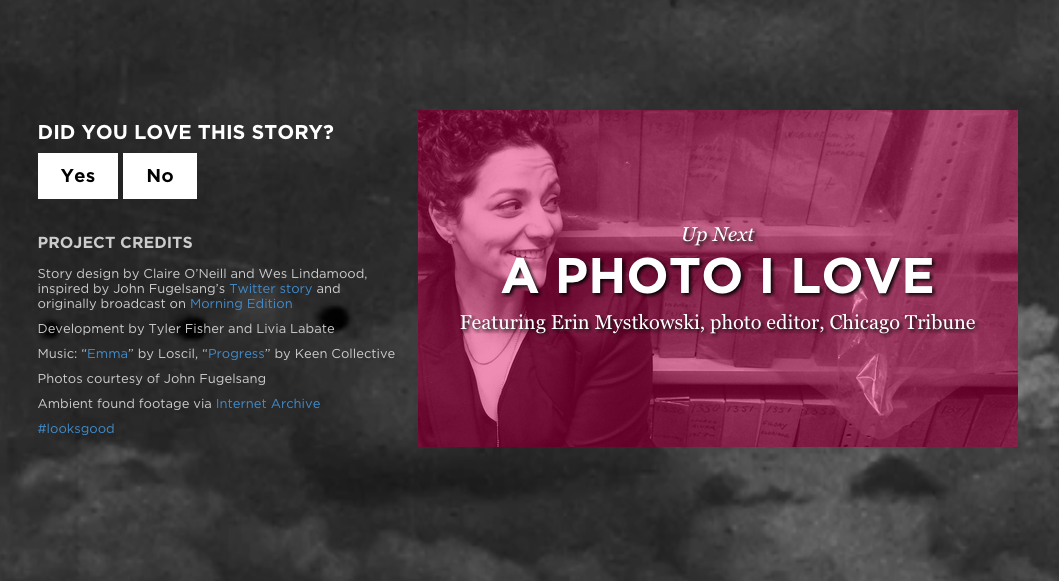
The Care Question used in A Brother And Sister In Love
Determining whether the results were statistically significant required some pretty complex calculations, which you can read about here. Luckily, Hubspot provides a simple-to-use calculator to determine the statistical significance of your results.
Significance is determined by the confidence interval, or how confident you can be that your numbers are not determined simply by randomness. Usually, a 95% confidence interval or greater is high enough to draw a conclusion. Using the calculator, we determined whether the difference in conversion rates (where conversion rate is defined as clicks over the number of times a particular test was run) was statistically significant.
“A Brother And Sister In Love”
The test for “A Brother And Sister In Love” was actually two separate A/B tests at the same time: whether a user was prompted to follow Look At This on social media or support NPR by donating. For each scenario, users were prompted with the Care Question or not. The Care Question was “Did you love this story?”
This breaks down into two tests, a “follow test” and a “support test”, with a control and variation scenario for each:
Follow test, control
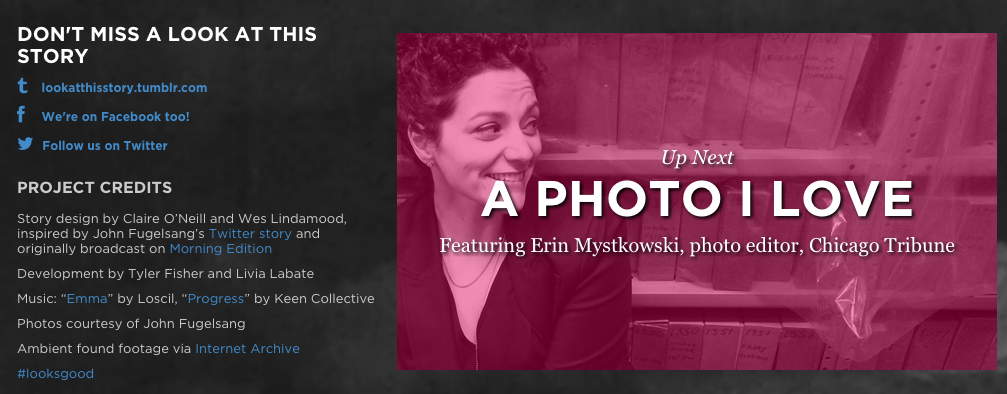
Follow test, variation
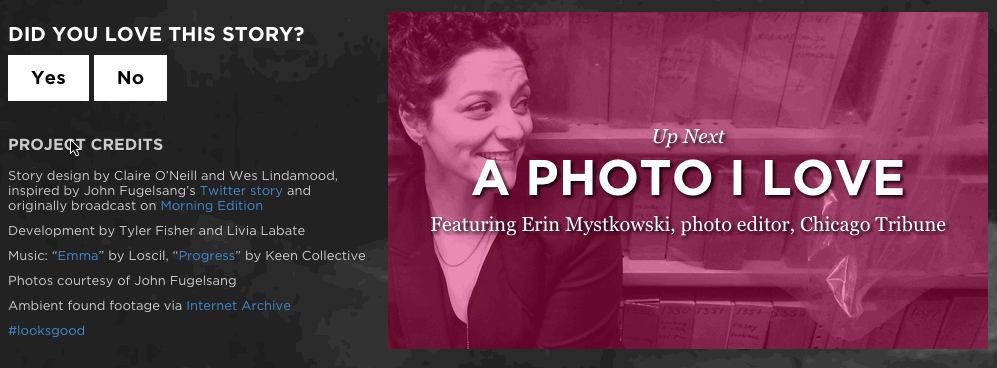
Support test, control
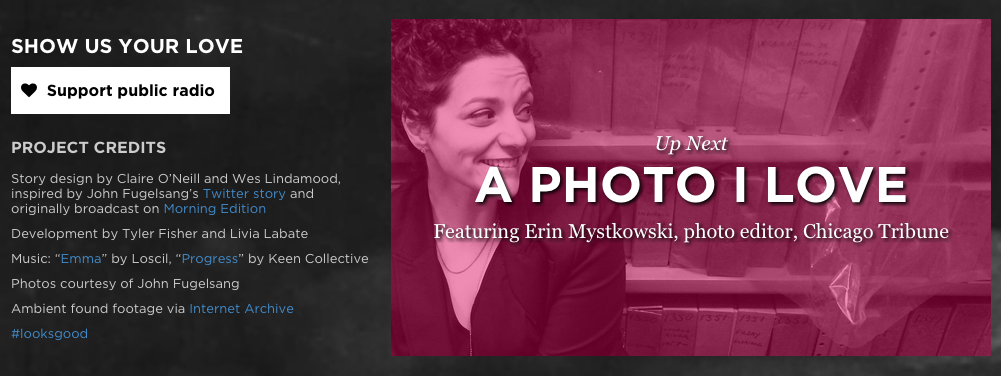
Support test, variation
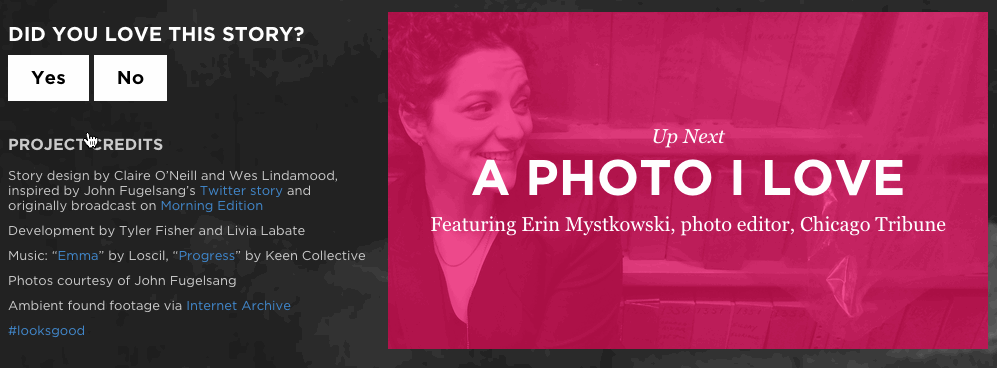
Finally, if a user clicked no, we provided a prompt to email us feedback.
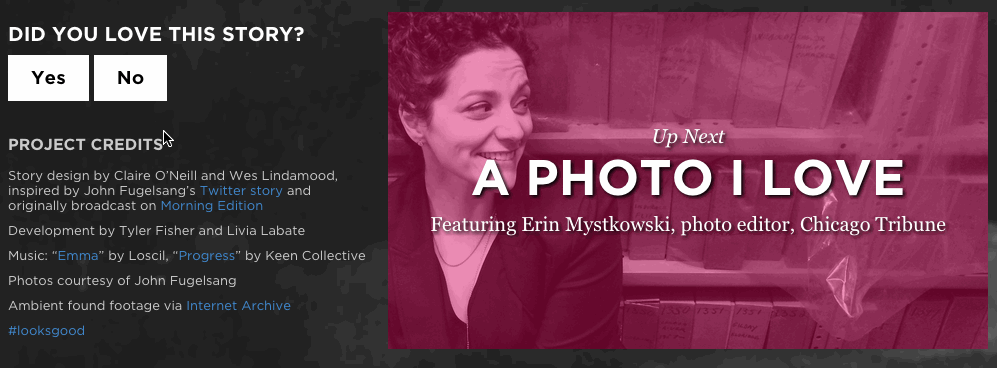
If a user answered “No” to the Care Question, we asked them to email us feedback.
We were able to determine with 99.90% confidence that prompting a user with a question before asking them to “Support Public Radio” was more successful. We converted 0.184% of users who did not receive the Care Question and 1.913% of users who did, which makes a user who received the Care Question 10 times more likely to click the support link.
“Life After Death”
One week later, after we had seen the preliminary results of our test from “A Brother And Sister In Love”, we ran another test on “Life After Death”. This was not a story associated with Look At This, and there was not an equivalent NPR property to follow, so we decided to hone our test on converting users to the donate page.
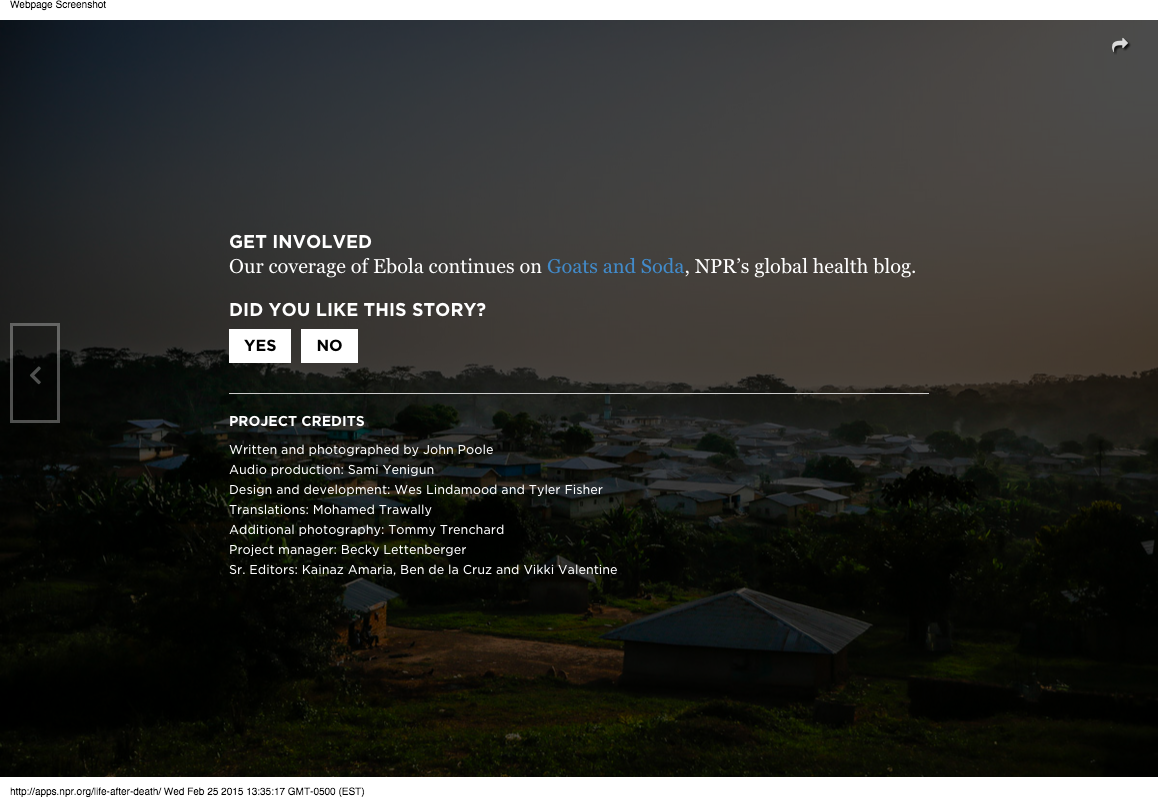
We wanted to confirm that users would convert at a higher percentage when presented with a Care Question first, so we kept the same control scenario. Instead of only using one question, we decided to run a multivariate test with four possible different phrasings. The control scenario and the four question variations each received ~20% of the test traffic. The four possible questions were:
- Did you like this story?
- Did you like this story? (It helps us to know)
- Does this kind of reporting matter to you?
- Does this kind of reporting matter to you? (It helps us to know)
For this test, we tested each question against the control scenario – presenting the user with a support button without showing them a question first.
Once again, we determined that presenting users with a Care Question before asking them to support public radio was a more successful path. Each of our four questions outperformed the control scenario at > 95% confidence intervals. Of the four questions, the two asking “Does this type of reporting matter to you?” were the best performers, which perhaps suggests that tailoring the Care Question to the content is the best course of action. Life After Death is a harrowing, intense story about a devastated village in Liberia, so perhaps asking a user if they “liked” a story was offputting in this case.
“A Photo I Love: Thomas Allen Harris”
A week later, we were able to run another test on a very similar story. It was a slide-based story that was also driven by the audio. We decided to rerun our original test, but fix our errors when logging to Google Analytics to create a better testing environment.
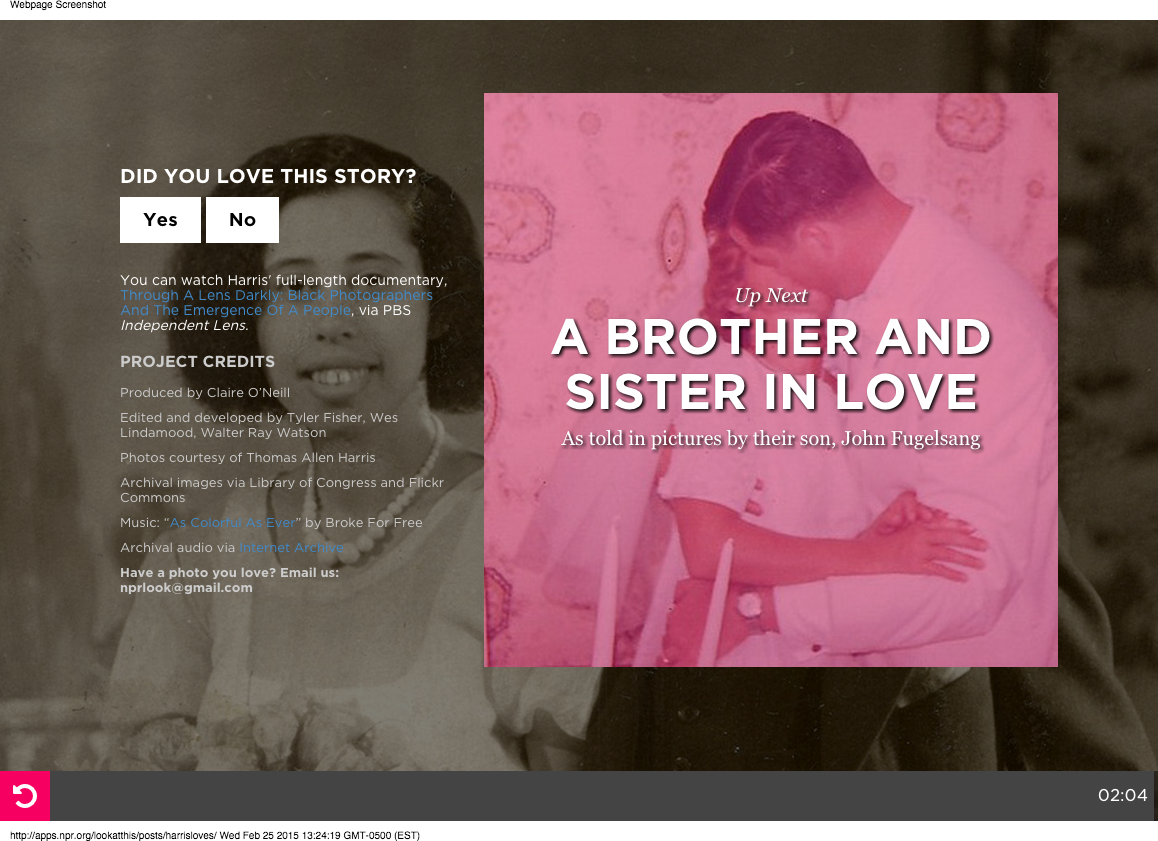
We left the same Care Question, “Did you love this story?”, and maintained our Look At This follow links.
Once again, we determined that giving users a question before a prompt to take action is a more successful path to conversion (1.7 times better for the Follow action and 13.5 times for the Support action).
Lessons Learned
We learned a lot in a short amount of time: some things about the stories themselves, a lot about the running of live tests and the math behind it. A few insights:
With our third test confirming that the Care Question has a positive impact on performance of actions presented at the end of stories, we feel confident implement this behavior by default going forward.
We also demonstrated that the language used to frame the Care Question matters. So far, aligning the tone of the question with the tone of the story has proven most successful.
Running the same test twice helped us simply validate that everything was working as planned. We are new to this, so it’s not a bad idea to double check!
Given the nature of the traffic for our stories (2-4 days of high volume followed by a long tail of decreased traffic), we need to make sure statistical significance is achieved within the first few days, as running a test for a longer period of time doesn’t add much at all.
Calculating the right sample size for a test is always a concern and particularly difficult when you don’t have a reliable cadance for what traffic to expect (since it varies from story to story), so we found we don’t need to do that at all. Instead, we can simply expose the entire audience for a story to the test we run and make the most of it as soon as possible.
We made several mistakes while analyzing the data simply because this is not something we do every day. Having multiple people look at the analysis as it was happening, helped us both correct errors and get a better understanding of how to make sense of the numbers.
Google Analytics automatically samples your default reports if your organization’s overall sessions exceed 500,000. To analyze tests like these you will want to make sure you have a full picture of your audience, so request an unsampled report (available from GA Premium only) so you can ensure your test is valid and reliable.
Also, with Google Analytics dropping support for custom variables, use distinct events to identify the variations of your test instead.
Work with us this summer!
Hey!
Are you a student?
Do you design? Develop? Love the web?
…or…
Do you make pictures? Want to learn to be a great photo editor?
If so, we’d very much like to hear from you. You’ll spend the summer working on the visuals team here at NPR’s headquarters in Washington, DC. We’re a small group of photographers, videographers, photo editors, developers, designers and reporters in the NPR newsroom who work on visual stuff for npr.org. Our work varies widely, check it out here.
Photo editing
Our photo editing intern will work with our digital news team to edit photos for npr.org. It’ll be awesome. There will also be opportunities to research and pitch original work.
Please…
- Love to write, edit and research
- Be awesome at making pictures
Are you awesome? Apply now!
Design and code
This intern will work as a designer and/or developer on graphics and projects for npr.org. It’ll be awesome.
Please…
- Our work is for the web, so be a web maker!
- We’d especially love to hear from folks who love illustration, news graphics and information design.
Are you awesome? Apply now!
What will I be paid? What are the dates?
The deadline for applications is March 20, 2015.
Check out our careers site for much more info.
Thx!
The Impact of Sustaining givers on Public Radio Fnd Drives
The movement to monthly sustaining givers has been good for many public radio stations, improving annual donor retention and monthly cash flow. The impact on fund drives is less clear.
There's not a lot of readily available national data on the subject, but we've seen mixed results across a few dozen client stations over the past three years. It appears the increase in sustaining members has reduced fund drive efficiencies for two reasons.
The pool of donors who might renew their membership during the drive is smaller because many of the most loyal donors are now sustainers. And additional gifts are a tougher sell since part of the sustainer pitch is that the listener is already supporting the station every month.
These two issues seem to have a greater effect on stations that ran efficient fundraising programs prior to seeking sustaining members. Stations that were less efficient to begin with get a longer grace period before their on-air drives are affected.
Perhaps a bigger issue now facing many stations is the multi-year impact of sustainer programs on fund drive cash flow. Every station has to manage the initial cash flow hit of starting a sustainer program. That's because the pledges that used to fulfill all at once now take 12 months to fulfill. The later in the fiscal year a sustainer is acquired, the less cash flow value that listener has in the current fiscal year.
In theory, the station is trading short-term fund drive cash for ongoing monthly sustainer cash. In practice, we are seeing stations trying to increase both. As a result, fund drive cash flow expectations are no longer being adjusted proportionately to sustainer pledges received during the drive. Drive goals are going up in a more difficult fundraising environment.
Here’s an example using a station with a drive goal of $300,000 in pledged dollars. Sorry about all of the numbers.
Prior to its sustainer program the station could count on $270,000 or more of that $300,000 to fulfill in the fiscal year. With a sustainer program, at least $100,000 of the pledged dollars are now being paid monthly (1/3 of pledged dollars).
If that drive occurs halfway through the fiscal year, then only half of the sustainer money fulfills in the fiscal year. That’s a $50,000 hit to fiscal year cash flow. Now only $220,000 fulfills in the fiscal year. Over three drives, on-air fundraising contributes $100,000 less per year to cash flow.
What we’re starting to see is that after the initial implementation of a sustainer program, stations aren’t willing to take that big of a cash flow hit on the fund drive revenue line. Rising budgets keep putting pressure on fund drives to deliver more immediate cash. So fund drive cash flow expectations are no longer being reduced deeply enough to account for sustainers. In some cases cash flow goals are approaching the same levels as the pre-sustainer drives.
The consequence is that the station has to raise its overall fund drive goal to meet the cash flow projection for the drive. Going back to our example, to raise $270,000 in current fiscal year cash with the sustainer model, the drive goal now has to be $380,000. That’s 27% higher than the pre-sustainer model. In a tougher on-air fundraising environment.
As a rule of thumb, the more successful a station is with sustainers, the less reliant it must become on fund drives for cash flow. It also must become better at multi-year, multi-channel revenue planning. If it doesn’t, then drive goals must be increased with the understanding that getting more immediate cash out of a drive and getting more sustainers from that drive are conflicting goals.
The problem, as we are seeing it, is that an increasing number of stations want both and that's not working.
A few decades ago, when public radio was investing considerable resources in on-air fundraising research and training, I posed the question, "Pledge drive or Fund drive?” That is - is the main purpose of this drive to get donors or money? It is an important question that impacts fund drive strategy, tactics, and messaging.
It turns out that public radio's incredible audience growth over those decades made that question less important than we thought. Most stations picked raising money as their primary goal and got enough new members along the way to grow, even though the percentage of new member donations was quite low.*
The success of sustainer programs and the importance of acquiring sustainers through on-air drives just might be making "Pledge drive or Fund drive?" a more relevant question today.
---------
* New givers in most fund drives range from 25% to 35%. It has been that way for a few decades. Flip that number around and it means that 65% to 75% of givers during an on-air fund drive are already in the station’s donor database. These percentages are a result of focusing on raising money during drives over acquiring new givers.
It’s Taking More Leverage to Generate Pledge Drive Contributions
Leverage is the weight of the incentives offered to generate a contribution or to raise a dollar. Leverage is the stuff – premiums, challenge grants, dollar-for-dollar matches, sweepstakes – offered during the drive to spike response rates and influence average gift.
We’re still working on the best way to measure this, but it is an important concept. On one hand, incentives are a cost to the station – financial and in terms of listener perception. We know from Listener-Focused Fundraising research that commercial-like fundraising tactics create negative perceptions among many listeners and that is a cost.
On the other hand, incentives create an important value proposition for an significant subset of potential givers. This post focuses on the idea of value proposition.
But Wait There’s More!
It used to be that using one incentive at a time was sufficient leverage to meet hourly and daily on-air drive goals. Sometimes two incentives, such as a premium and a dollar-for-dollar match were offered simultaneously. Now, more stations are offering more stuff, simultaneously, to meet their goals.
The questions before us are how much leverage is really necessary for a station to get the results it needs? And, is there a point where so much leverage is needed to meet the pledge drive goal that it is a sign of an unrealistic goal?
In the interest of full disclosure our company, Sutton & Lee, provides on-air fundraising consulting services to nearly a dozen public radio stations. We are helping many of those stations use increased leverage to meet their goals.
Below is an example of what one major market station offered as sweepstakes prizes during a recent campaign. The example below is not one of our client stations but it represents how a handful of stations have been operating over the past decade and we think it represents where much of the industry is headed.
- Trip for two to Paris
- Tanzanian Safari for two
- Trip to Iceland
- WWDTM Trip to Chicago
- Galapagos trip
- Rome and Florence trip
- Mercedes Benz
Depending on when a listener was asked, the enticement to respond during this drive would have been entry into sweepstakes for multiple trips, a chance to win a Mercedes, a $50,000 challenge grant, and an attractively priced premium.
The value proposition to the listener is this:
“Give $10 per month now to get a great thank you gift at a special pledge level and also support the station you depend on so you can maintain access to your favorite programs. You’ll also get many chances to win a dream vacation and a chance to win a luxury car all while turning that $10 per month into a $50,000 challenge grant the station can earn if you do it by the end of the hour.”
While this might seem extreme to the outside observer, leaders at this station obviously felt all of these incentives were needed to meet the goal over their planned fundraising footprint. That’s a lot of leverage.
And this station is not alone. Many stations are giving away multiple trips. Others are giving away cars and even tens of thousands of dollars in cash.
It’s Not a Bake Sale Anymore
And it’s not just the sweepstakes that are getting extreme. Some stations offer “early bird” discounts on premiums, where the pledge level starts low and goes up later in the drive. While very commercial sounding, this technique does boost immediate response rates.
Some stations offer “two-for-one” matches where every dollar contributed generates two additional dollars in match money. To the listener this is, “give $100 right now and the station receives an extra $200 donation from a generous major donor to the station. Right now your pledge has three times the buying power.”
These two-for-one matches can be very effective at generating immediate response. They are often four times more effective than incentive-free fundraising at generating contributions and dollars.
The value proposition of matches is also quite good from the listener perspective. Unlike a sweepstakes, which the listener may or may not win, there is an instant benefit to responding. The listener gives and the station gets even more. Instantly!
The primary downside of two-for-one matches for the station is that a dollar of leverage returns just 50 cents in revenue. The pledges come in faster, which is good, but the cash return on the leverage is lower than the value proposition to the listener.
We’ve seen stations raise less money in an entire day than they used for a two-for-one match during that day. For example, $30,000 in match money generates $15,000 in contributions over a few hours. Then the rest of the day generates $10,000 in pledges. The daily pledge total is $25,000 but it took $30,000 in match money to get it.
It’s a reasonable argument to point out that the any match or challenge in a pledge drive is worthwhile because the station leveraged the pledge drive to obtain the match money commitment in the first place. We agree. That’s one of the great strategic benefits of matches and challenges. They raise money twice for the station, once before the drive and once during the drive.
But from the potential donor’s perspective a two-for-one match is the antepenultimate pledge drive offer. It’s big leverage. The only thing that makes it better is getting a discounted premium and a chance to win a great sweepstakes prize while getting your gift tripled.
Circling back to the big question in front of us, “how much leverage is too much?”
Are we at the point where meeting goals requires offering incentives worth more than the value of the contribution itself? Is there an ideal ratio of pledge drive dollars to incentive value.
Defining leverage in this way could help underperforming stations get better results or at least better manage their expectations. It could also help stations efficiently meet their goals without going overboard.
Another benefit is improved pledge drive benchmarking. It’s almost impossible to compare results across stations without considering the leverage applied at each station.
Finally, we can’t leave this discussion without asking if there is a point where greater reliance on commercial tactics makes pledge drives even less-listenable and/or erodes the bond between the station and listeners who value the non-commercial nature of public radio.
Four Diverse Media Startups Win Encore Entrepreneur Funding
Posted To: Press Releases
|
For immediate release Feb. 5, 2015 |
Contact: Jan Schaffer jans@j-lab.org |
Washington, D.C. – Four media startups proposed by entrepreneurs over 50 have been selected to receive $12,000 each in encore media entrepreneur funding, J-Lab announced today. The projects are a single-topic magazine on Medium.com, a Connecticut hyperlocal FM/streamed radio station, daily Internet radio newscasts and podcasts for a Pacific Northwest blog network, and an Hispanic crowd-sourced initiative on border-crossing deaths.
The four initiatives were among 82 applications received in J-Lab’s Masters Mediapreneurs initiative to help seed media startups launched by Baby Boomers, aged 50-plus.
“We could easily have funded several more worthy projects,” said J-Lab director Jan Schaffer. “The ideas were creative, the energy striking, and the applicants’ eagerness was quite pronounced.”
“Many who applied tipped their hats to this opportunity to validate ideas from mature news creators and help them make them happen.”
The winners are:
Midcentury/Modern, an online magazine “following Boomers into their Third Act,” launched in late December by hyperlocal news entrepreneur Debra Galant, the founder of Baristanet and now director of the NJ News Commons. Instead of creating a stand-alone website, the magazine is publishing on Medium, a social journalism blogging platform that allows people to recommend and share posts Twitter-like. It is one of the first publications receiving independent funding to launch on Medium, which is also offering technical and revenue support. “This online magazine explores how the definition of aging shifts when it happens to the cohort that defined itself by its youthfulness,” Galant said.
The LP-FM New-Media Newsroom, a new FM/web-streamed radio station for New Haven, CT, shepherded by New Haven Independent founder Paul Bass in partnership with La Voz Hispana, the local Spanish-language weekly. Daily four-hour news programs, to start, will be in English and Spanish and feature local African-American hosts. “We're excited about launching an FM/web-streamed community radio station in the fall,” Bass said. “We envision this as one model for not-for-profit, public-interest local news sites like ours to expand on the journalism we do and broaden our racial and ethnic makeup and outreach.”
SoKing Internet Radio, daily newcasts to feature content from South King Media company’s six community blogs covering South King County near Seattle. Scott Schaefer, founder of the B-Town Blog and South King Media is leading the project. “This will allow us to start up a truly innovative new program – daily hyperlocal newscasts that will live not only on our 24/7 streaming radio station, but also as podcasts posted to South King Media’s six local blogs and Facebook pages,” Schaefer said.
EncuentrosMortales.org, a Spanish-language website and database to collect public records and media reports of undocumented people killed during interactions with law enforcement officers along the southern border of the U.S. It is a project of D. Brian Burghart, who created an English version, FatalEncounters.org, and is editor and publisher of the Reno News & Review. “I’m very excited to be able to move forward with EncuentrosMortales.org. Law-enforcement-involved homicides along the U.S. border is an important and underreported issue, and I hope we can bring together technology, languages and volunteers to get a much better idea of our government’s activities,” he said.
The Masters Mediapreneurs progam is funded with grants from the Ethics and Excellence in Journalism and the Nicholas B. Ottaway Foundations.
Participating in the judging the applications were Ju-Don Roberts, Director of the Center for Cooperative Media, Montclair State University; Tiffany Shackelford, Executive Director, Association for Alternative News Weeklies; Jody Brannon, Digital Media Strategist and former National Director News 21, and Jan Schaffer, Executive Director, J-Lab.
J-Lab, founded in 2002, is a journalism catalyst. It funds new approaches to news and information, researches what works and shares practical insights with traditional and entrepreneurial news organizations. Jan Schaffer is also Entrepreneur in Residence at American University.
RadioSutton 2015-02-03 02:52:00
Sometimes the cost is more on-air fundraising. It is taking more of the station’s time and more of the listeners’ time to generate a contribution. Sometimes the cost is greater leverage. That is – stations are having to offer more, or more expensive, incentives to generate a contribution.
Probable Causes
Success with monthly Sustaining givers appears to be having an effect on drives by cutting into the potential number of annual renewals received during the drive. Declining AQH (Average Quarter-Hour) audience is another possible cause. Lower AQH means listeners are using the station less. That could result in listeners being less likely to give. It certainly reduces the number of potential respondents to an on-air fundraising appeal.
There could be external factors as well. People are being asked to immediately part with their money at unprecedented rates these days. The junk mail and telemarketing calls of 25 years ago now follow us out of our homes and find us 24/7. The amount of daily asks is numbing. Public radio pledge drives appeals are fighting through much more clutter just to be considered let alone acted upon.
Measuring Pledge Drive Success
The primary metric we use to measure on-air fundraising success is Listener-Hours to Generate a Contribution. Using Nielsen Audio audience data, we answer the question, “how many hours of listening must we expose to fundraising to get someone to give?”
Or, put another way, how efficiently are we spending our listeners’ time to get a single contribution? A lower number is better. The goal is to maximize the pledge drive return against the expense of the disrupting the listening experience.
In a PPM-measured market, an efficient pledge drive for an NPR News station generates one contribution for every 300 hours of listening exposed to fundraising. That’s like putting 300 people in an auditorium and playing public radio content for an hour, except that their experience will be interrupted 4 to 5 times in that hour with 4 to 6 minute fundraising appeals. At the end of that hour, one of the 300 people will make a contribution in the amount of an average gift.
Two Trends
We see on-air fundraising following two trends. Some stations are adding more fundraising hours and exposing more listening to pledge drives to meet their goals. The fundraising efficiency metrics at these stations don’t improve, they get worse. The stations still meet their goals, or come relatively close, by applying more brute force.
The other trend involves applying more Leverage to the fundraising ask. We haven’t settled on exactly how to best measure Leverage, but we believe the broader concept is sound. For now, consider the Leverage to be the weight of the incentives offered to generate a contribution or to raise a dollar.
Here’s an example. Ten years ago a station offers a dollar-for-dollar match and the fundraising efficiency is 150 Listener-Hours (LH) per Contribution. That means the match is twice as efficient as the average hour of fundraising, which took twice as many LHs (300) to generate a contribution.
Today that match has an efficiency of 200 LHs per Contribution. It’s less efficient at turning listening in to contributions. So the station decides to offer a free tote-bag to anyone who gives during the match in addition to any other thank you gift they take. More listeners respond to the offer and the efficiency returns to its prior number of 150. The station achieved its prior efficiency by applying more Leverage.
This is happening at a lot of stations across the country stations. They are offering more incentives each drive and offering more of them simultaneously to maintain fundraising efficiencies.
Is the Problem Too Much Talk About Stuff and Not Enough Talk About Mission?
Probably not.
Mission messages are great for convincing listeners that they should give to the station but they aren’t particularly effective at motivating people to actually pause their busy lives to give at that moment. The well-executed “Mission” focused fundraising hours tend to fall in the 400-500 LH efficiency range.
A pure Mission approach to pledge drives would likely require a plan that exposed listeners to 33% to 50% more fundraising to meet the overall drive goal. That’s like turning a 9-day pledge drive into a 12 to 14-day pledge drive. As you might imagine, longer drives tend to drive efficiencies down even more.
What’s Next?
Subsequent postings on this topic will go a little deeper into Leverage, Sustainers, and off-air fundraising including the use of email, social media and database solutions.
One final note. In the past we’ve observed that public radio might have more of a spending problem than a fundraising problem. The money stations are spending on increased local news offerings and digital initiatives is outpacing their ability to monetize those activities. They are currently money losers. That puts pressure on the core radio service to generate “profits” to subsidize those activities.
One of the possible answers to slipping pledge drive efficiencies is to reduce the revenue burden they must bear through smarter spending on local news and digital.
Baking Chart Data Into Your Page
Do you use our dailygraphics rig to create and deploy small charts? We’ve introduced a new feature: The latest version of copytext.py (0.1.8) allows users to inject serialized JSON from a Google Spreadsheet onto their page with one line of template code.
Benefits:
- Store your text and your data in the same Google Spreadsheet, making editing a little simpler.
- The data is baked right into your page, so there’s one fewer file to load.
(Thanks to Christopher Groskopf and Danny DeBelius for making this work.)
If you’re already using dailygraphics, pull the latest code from GitHub (we’ve updated libraries and made other bugfixes in recent weeks), and update requirements:
pip install -Ur requirements.txt
You can see this at work in a graphic published today on NPR.org.
Here’s How It Works
The following examples assume that you are using our dailygraphics rig. Both examples point to this Google Spreadsheet.
The spreadsheet has three tabs:
labels: Text information (headline, credits, etc.)data_bar: The data for the bar chart example belowdata_line: The data for the line chart example below
Note: Copytext works best when all values (even numeric ones) are cast as text/strings in the Google Spreadsheet, rather than numbers or dates. You can convert them to their proper types later in JavaScript.
Bar Chart (Source code on GitHub)
In child_template.html, add a <script></script> tag above all the other JavaScript embeds at the bottom of the page, and then declare the variable for your data.
<script type="text/javascript">
var GRAPHIC_DATA = {{ COPY.data_bar.json() }};
</script>
GRAPHIC_DATAis the variable name you’ll use to reference this dataCOPYrefers to the overall spreadsheetdata_baris the name of the specific sheet within the spreadsheet (in this case, the spreadsheet has three sheets)
The result looks like this, with the keys corresponding to the column headers in the table:
<script type="text/javascript">
var GRAPHIC_DATA = [{"label": "Alabama", "amt": "2"}, {"label": "Alaska", "amt": "4"}, {"label": "Arizona", "amt": "6"}, {"label": "Arkansas", "amt": "8"}, {"label": "California", "amt": "10"}, {"label": "Colorado", "amt": "12"}, {"label": "Connecticut", "amt": "14"}];
</script>
In js/graphic.js, don’t bother with declaring or importing GRAPHIC_DATA — just go straight to whatever additional processing you need to do (like, in this case, explicitly casting the numeric values as numbers).
GRAPHIC_DATA.forEach(function(d) {
d['amt'] = +d['amt'];
});
Line Chart (Source code on GitHub)
In child_template.html, add a <script></script> tag above all the other JavaScript embeds at the bottom of the page, and then declare the variable for your data.
<script type="text/javascript">
var GRAPHIC_DATA = {{ COPY.data_line.json() }};
</script>
GRAPHIC_DATAis the variable name you’ll use to reference this dataCOPYrefers to the overall spreadsheetdata_lineis the name of the specific sheet within the spreadsheet (in this case, the spreadsheet has three sheets)
The result looks like this, with the keys corresponding to the column headers in the table:
<script type="text/javascript">
var GRAPHIC_DATA = [{"date": "1/1/1989", "One": "1.84", "Two": "3.86", "Three": "5.80", "Four": "2.76"}, {"date": "4/1/1989", "One": "1.85", "Two": "3.89", "Three": "5.83", "Four": "2.78"}, {"date": "7/1/1989", "One": "1.87", "Two": "3.93", "Three": "5.89", "Four": "2.81"}, {"date": "10/1/1989", "One": "1.88", "Two": "3.95", "Three": "5.92", "Four": "2.82"} ... [and so on] ...;
</script>
In js/graphic.js, don’t bother with declaring or importing GRAPHIC_DATA — just go straight to whatever additional processing you need to do (like, in this case, explicitly casting the dates as dates).
GRAPHIC_DATA.forEach(function(d) {
d['date'] = d3.time.format('%m/%d/%Y').parse(d['date']);
});
Related Posts
Putting Radio On The Television
For election night 2014, we wanted to do something different.
We guessed that the dedicated wonks — the ones who want to drill down into detailed data and maps — would probably go to sources like the New York Times or Washington Post. Rather than reproduce that work, what could NPR do that would be unique, and would serve a broader audience?
To start, we had our organization’s thoughtful reporting and on-air coverage — a live event we could build something around. We had the results “big boards” we make every election year for the hosts in the studio (and shared publicly in 2012 — a surprise success). We had a devoted audience.
So we decided to throw a party — and put radio on TV.
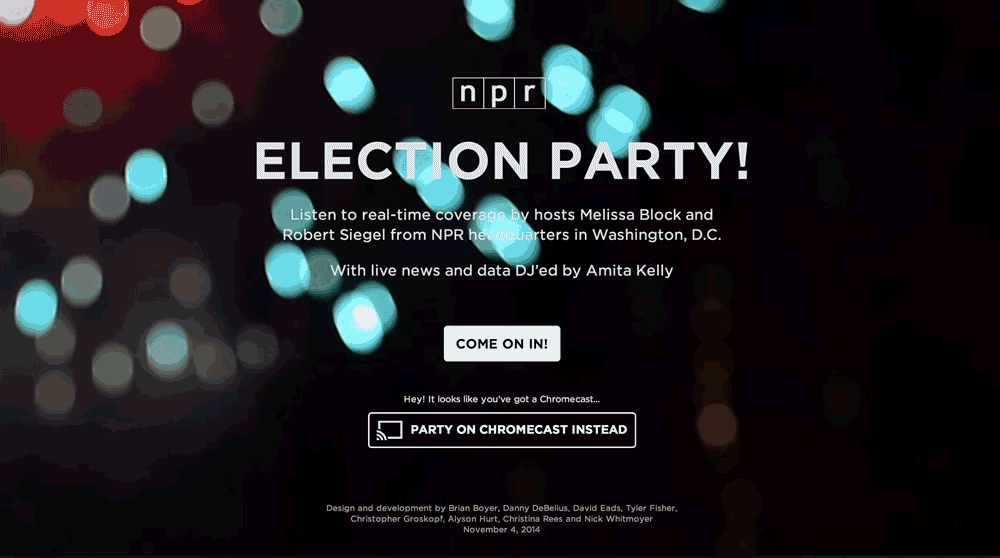
We built an app that people could pull up on their TVs or laptops or mobile phones and leave on in the background during their election parties. We imagined users muting cable news and listening to us instead — or even replacing cable news entirely for some users. We built in Chromecast support and made reaching out to cord-cutters part of our marketing pitch.
Did it work? Here’s what we learned.
Note: The usage figures cited below refer to a one-day slice of data: Nov. 4, 2014 (EST). The practice of measuring web usage is an inexact science — time on site is particularly problematic — so all of these figures are best read as estimates and used for relative comparison, not absolutes.
Traffic / Usage
| Overall | 7 minutes, 01 second |
| Desktop | 10 minutes, 19 seconds |
| Tablet | 5 minutes, 52 seconds |
| Mobile | 2 minutes, 57 seconds |
| Desktop | 54.5% |
| Mobile | 33.6% |
| Tablet | 11.9% |
| Chrome | 41.1% |
| Safari | 21.8% |
| Safari (in-app) | 17.5% |
| Firefox | 11.5% |
| Internet Explorer | 5.0% |
(Chrome usage likely also includes Chromecast. Safari (in-app) figures reflect users opening links within iOS apps, such as Twitter and Facebook.)
Browser usage of our app generally tracked with that of the overall NPR.org site. Exceptions: The share of Chrome users was a few percentage points higher for our app; the share of Internet Explorer users, a few percentage points lower.
Non-Interactivity
This project involved a lot of a little experiments aimed at answering one larger question: Will users appreciate a more passive, less-interactive election night experience?
As it turns out, this is a remarkably difficult thing to measure. We can’t know if our users put their laptop down on the coffee table, if they were with friends when they used it or if they plugged their laptop into their TV. Instead, we have to make inferences based on session duration and our relatively meager event tracking.
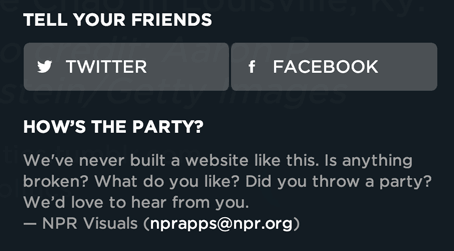
Overall, the feedback we received was quite positive. We prompted people to email us, and most of the folks who did so said they were happy with the experience.
Slide Controls
Although we optimized for a passive user experience, we needed to include some controls. From the very beginning our stakeholders asked for more control over the experience. We made an effort to balance this against our belief that we were building more for a distracted audience.
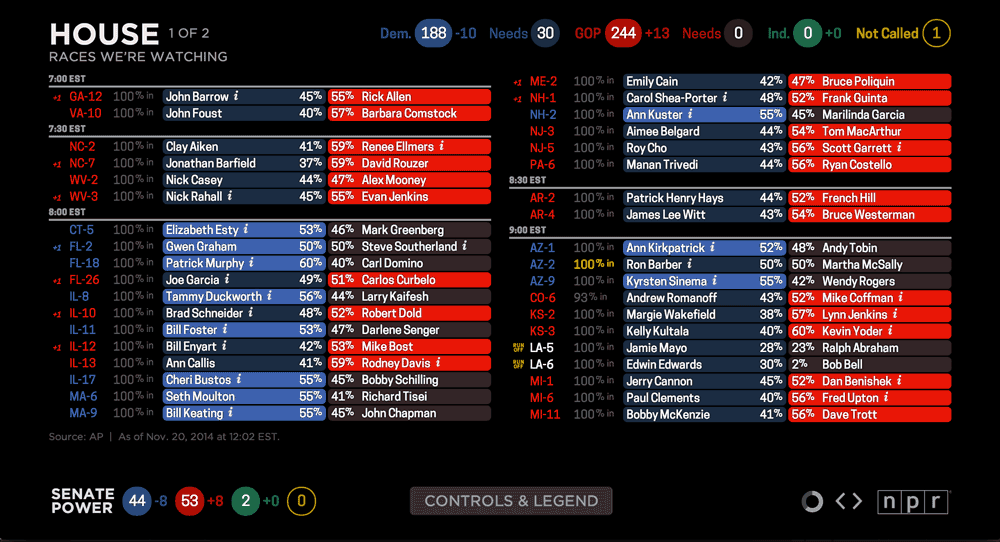
For passive users, each slide included a countdown spinner to signal that the display would change and to indicate how much time remained until the app would auto-advance to the next slide.
For more active users, we included “previous” and “next” buttons to allow users to skip or return to slides. 27 percent of users clicked the “next” button at least once to skip, while 18 percent used the “previous” button. 11 percent figured out that they could skip slides using their keyboard arrow keys. (We didn’t include any clue to this feature in the UI.) About a third of those who emailed us said they would have liked even more control, such as a pause button.
Audio Controls
The live radio broadcast would auto-play when users entered the app. 8 percent of users clicked the mute button. (Not including users who may have used the audio controls on their devices.)
Personalization
We guessed that, in addition to national election results, users might also want to see results for their state.
Our original plan was to ask our users to choose their state when they arrived. But as we learned from user testing and fine-tuned the welcome process, we killed the intermediary “pick your state” screen. Instead the site would guess the user’s location, and users could change their state via the controls menu.
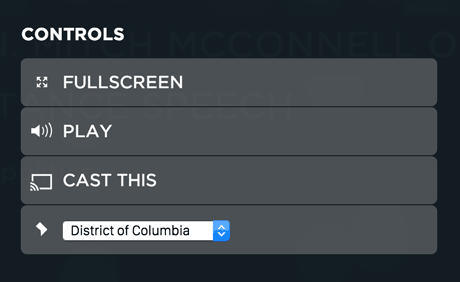
6 percent of users interacted with the state dropdown. The list of top states users switched to hints at interest in certain contentious races (Senate seats in Kentucky and Colorado, for example), regardless of where the user was actually located.
- Kentucky
- Colorado
- California
- Florida
- Arkansas
We heard feedback that some users who did use the dropdown were unsure of its purpose. If we had more time, we might have put more time into this feature. We hoped that if our attempt at presenting location-specific results worked seamlessly for most users, it would be okay.
The Chromecast Hypothesis
Our working theory was that Chromecast users would be the most passive in their interaction with the app — likely throwing it up on the TV and just letting it run — and therefore they would spend more time with it. And that theory held true: Chromecast users spent an average of 19 minutes and 53 seconds on the site (compared to the overall average of 7 minutes and 1 second).
That said, the Chromecast audience was pretty small: In only 0.7 percent of visits did a user initiate a Chromecast session by clicking on one of our “Cast This” buttons. (This does not include users who may have cast the page using the Chrome browser extension.) But we heard from many Chromecast users who seemed very excited that we built something for them: 15 percent of the feedback emails we received and 13 percent of tweets talking about the app mentioned Chromecast.
(We originally intended to also support Roku and AirPlay “casting,” but the native Chromecast experience proved to be far superior to the “mirrored” offered by other devices. We hope to continue experimenting in this arena.)
On a related note, one surprise: 3 percent of users clicked the fullscreen button — more than double our Chromecast users. And these users stayed on the site even longer, an average of 31 minutes, 38 seconds.
Conclusion
This project gave us some useful insights into how users interact (or not) with an app designed to be experienced passively.
We also learned a lot about user analytics, from what behavior to track to how to query for results. Our insights were limited somewhat by the tools we had and our ability to understand them — Google Analytics can be pretty opaque.
On all these counts, we’ll continue to try new things and learn with future projects. We look forward to refining this experiment as we plan for the 2016 elections.
The Official PRPD Transition
My own plans are to take a little time to kick back but remain open to selected advising and consulting projects. Hope I'll get to work with some of you in my "semi-retirement".
Happy New Year to all and all the best wishes for a thriving future.
Arthur Cohen
PRPD Office Move in Progress
As of January 1, the new PRPD contact info will be:
PRPD
150 Hilliard Ave.
Asheville, NC 28801
(802) 373-7934
info@prpd.org
Responsive Graphics In Core Publisher With Pym.js
Editor’s Note: Core Publisher is a content management system that staff at many NPR member stations use to maintain their websites. This post is written for that audience, but may be useful for users of other CMSes.
Over time, many member stations have created maps, graphics and other projects for their websites that were sized to fit Core Publisher’s fixed-width layout. But with the responsive mobile-only sites, and Core Publisher going to a fully responsive design, these elements either don’t work or won’t resize correctly to the screen.
Now you can use Pym.js to iframe responsively-built projects within Core Publisher stories.
Achievement unlocked: I think I just got pym.js working on my CorePub mobile site https://t.co/AiP59h1UME
— Jim Hill (@ejimbo_com) December 2, 2014(Note: NPR Digital Services, the team behind Core Publisher, doesn’t maintain or support Pym.js and can’t help you use it. But they didn’t raise any concerns about this workaround.)
I Was Ready Yesterday, What Do I DO?
I like that enthusiasm. First of all, let’s get a few assumptions out of the way: We’re assuming you are familiar with working in Core Publisher, know the post building process, comfortable with working in the source code view in the WYSIWYG with HTML, and that you have a separate web space to host all of your files (KUNC, like the NPR Visuals team, uses Amazon’s S3 service).
1) Download Pym.js.. Follow the instructions to integrate it into your project. (In Pym.js terms: Your project is the “child” page, while the Core Publisher story page it will live on is the “parent” page.)
2) Publish your project to the service of your choice. Note the URL path: You’ll need it later.
3) Build a post as normal in Core Publisher and then switch to the source code view and locate in the code where you want to place your iframe.
4) Core Publisher often strips out or ignores tags and scripts that it doesn’t recognize when it publishes. We’re going to get around that by using tags that CP does recognize. We’ll use Pym.js’s “auto-initialize” method, rather than inline JavaScript, to embed our project on the page. But, contrary to the example code in the docs, don’t use <div> tags to indicate where the iframe will go — use <p> tags instead. You’ll also need the URL path to your project from step 2: That will be your data target. The tag will look like this: <p data-pym-src="http://example.com/project/"></p>.
Your target code for the iframe should look something like this:
<p>Bacon ipsum dolor amet cupim cow andouille tenderloin biltong pork belly corned beef meatball swine pastrami alcatra.</p>
<p data-pym-src="http://example.com/project/"> </p>
<p>Cupim beef ribs ribeye swine tail strip steak drumstick venison bacon salami pig chicken.</p>
Beware: Core Publisher often will ignore paragraph tags <p> that are empty when it publishes. To avoid this, insert a non-breaking space between the opening and closing <p> tags for your pym target. Sometimes the CP WYSIWYG hobgoblins will insert this for you as well.
5) Next, point to the Pym.js script file. <script> tags are sometimes hit-or-miss in Core Publisher, so you should save your work right now.
(Note: If you’re embedding multiple Pym.js iframes on a page, you only need to include this script tag once, after the last embed.)
6) Did you save?
7) Good, let’s place that script tag now. It should follow the last iframe target in your post and should only appear once. You’ll need your URL path to pym from step 2. The full tag will look like this: <script type="text/javascript" src="http://example.com/project/js/pym.js"></script>.
8) Your complete code should now look like this:
<p>Bacon ipsum dolor amet cupim cow andouille tenderloin biltong pork belly corned beef meatball swine pastrami alcatra.</p>
<p data-pym-src="http://example.com/project/"> </p><script type="text/javascript" src="http://example.com/project/js/pym.js"></script>
<p>Cupim beef ribs ribeye swine tail strip steak drumstick venison bacon salami pig chicken.</p>
Most of the time the script tag should be fine since it is a simple one — only the tag and URL, and no other arguments. Sometimes Core Publisher will still strip it out. This should be the last thing you place in your post before you save to preview or publish.
If you go in later and edit the post, double-check that the script wasn’t stripped out.
A good sign that the script wasn’t dropped? The following text might appear in the normal WYSIWYG text view: {cke_protected_1}. Don’t delete it: That’s script code.
Take a look at your post and revel in how cool that Pym.js-inserted element is. Or take a look at this example or this one.
What Gives? Your Example Isn’t On The Responsive Theme.
We’ll be transitioning to the responsive design in a few months. In the meantime, KUNC has a lot of legacy iframes that we’ll be going back to and embedding with Pym.js. And Pym.js works like a champ on the already-responsive mobile site, so these projects will work better for the quickly-growing mobile audience. Always think mobile.
So, Does It Work On The Responsive Theme?
It sure does! Anna Rader at Wyoming Public Media was kind enough to let me try a Pym.js test post on their newly-transitioned responsive site. Everything worked like a charm and there was much excitement.
Will The Pym Code In A Post Carry Over The API For Station-To-Station Sharing?
I haven’t tested this yet. If you’d like to be a test subject, let me know and we can give it a try. Looking at the raw NPRML in the API for a post with the pym code it in, it all seems to be there.
Have any questions? Find me on Twitter @ejimbo_com and ask away.
Improving User Engagement Through Subtle Changes: Updating the Book Concierge
The NPR year-end 2013 Book Concierge was a big hit. Instead of writing a bunch of lists, the books team solicited over 200 short reviews by critics and staff and put them into a single, beautiful website designed to make discovering great books fun. Readers loved it. For the 2014 Book Concierge, our goal was to build on last year’s success and resist the urge to rewrite the code or wildly redesign.
This is a catalog of small improvements, why we made them, and the difference they made. We’re using analytics for the first five days following the site’s launch. Overall, pageviews are slightly down from last year (337,000 in the first five days in 2014 versus 370,000 in 2013), but engagement appears to have increased fairly significantly.
Tag Styling
In the 2013 concierge the list of tags blends together, making them difficult to scan. To improve the tags’ legibility and click-ability, we tried different color combinations and styles with varying success. We tried alternating between 2 tag colors, as well as varying the tag length, but neither were satisfying.
Our final solution was to apply a color gradient over the list of tags. This transformed the tags into individually identifiable buttons that still feel like a cohesive unit. This year, there was an average of 2.7 tag selections per visit versus 2.3 in 2013, a 17% increase. In 5 days, about 86,000 people clicked the most popular tag (NPR Staff Picks), up from about 75,000 in 2013.
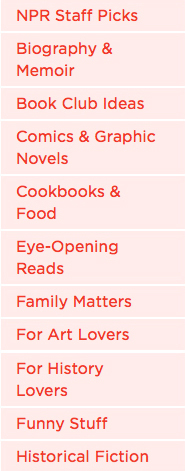
2013
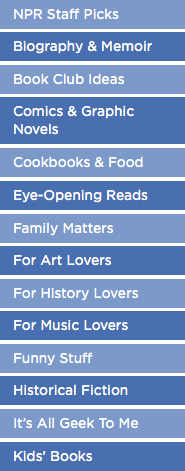
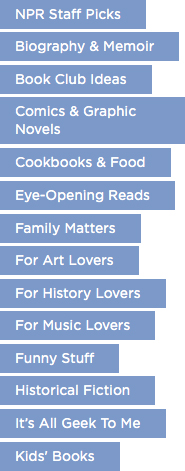
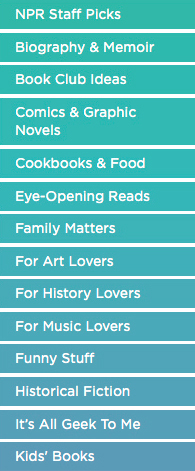
2014
Modal Improvements
We changed the modal design to help encourage users to read more book reviews. We replaced the modal’s ‘previous’ and ‘next’ buttons — which were tucked away at the bottom of the review — with side paddles. This allows viewers to easily click through the reviews without having to hunt for the buttons at the bottom of each review. We also changed the modal proportions so that it fits into a wider range of screen sizes without forcing the user to scroll. By putting a max-width on the modal and limiting the book cover image size, we eliminated a lot of dead white space which improves the user’s reading experience. We believe these changes worked. This year, users viewed an average of 3.7 reviews per visit, up 54% from 2013.
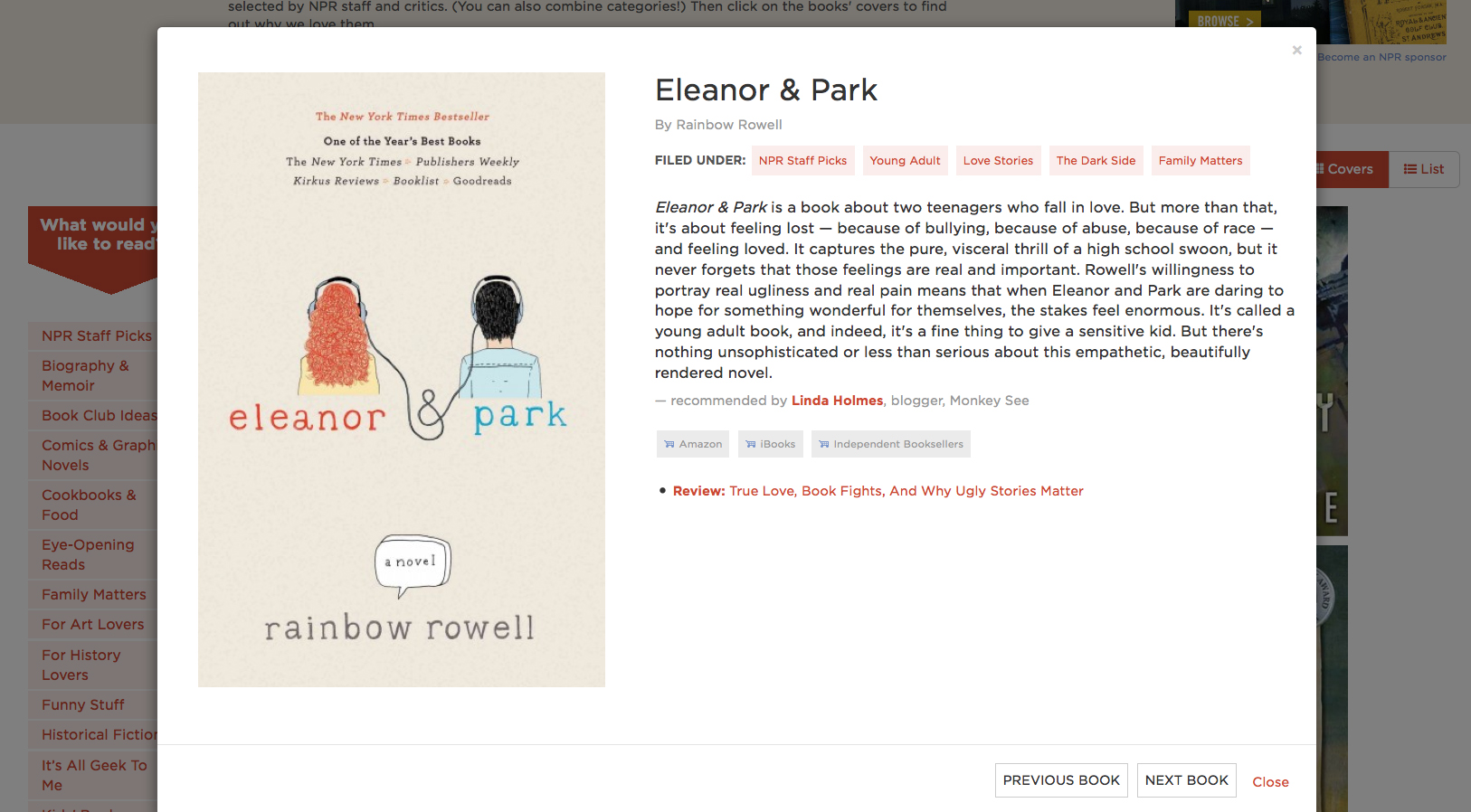
2013
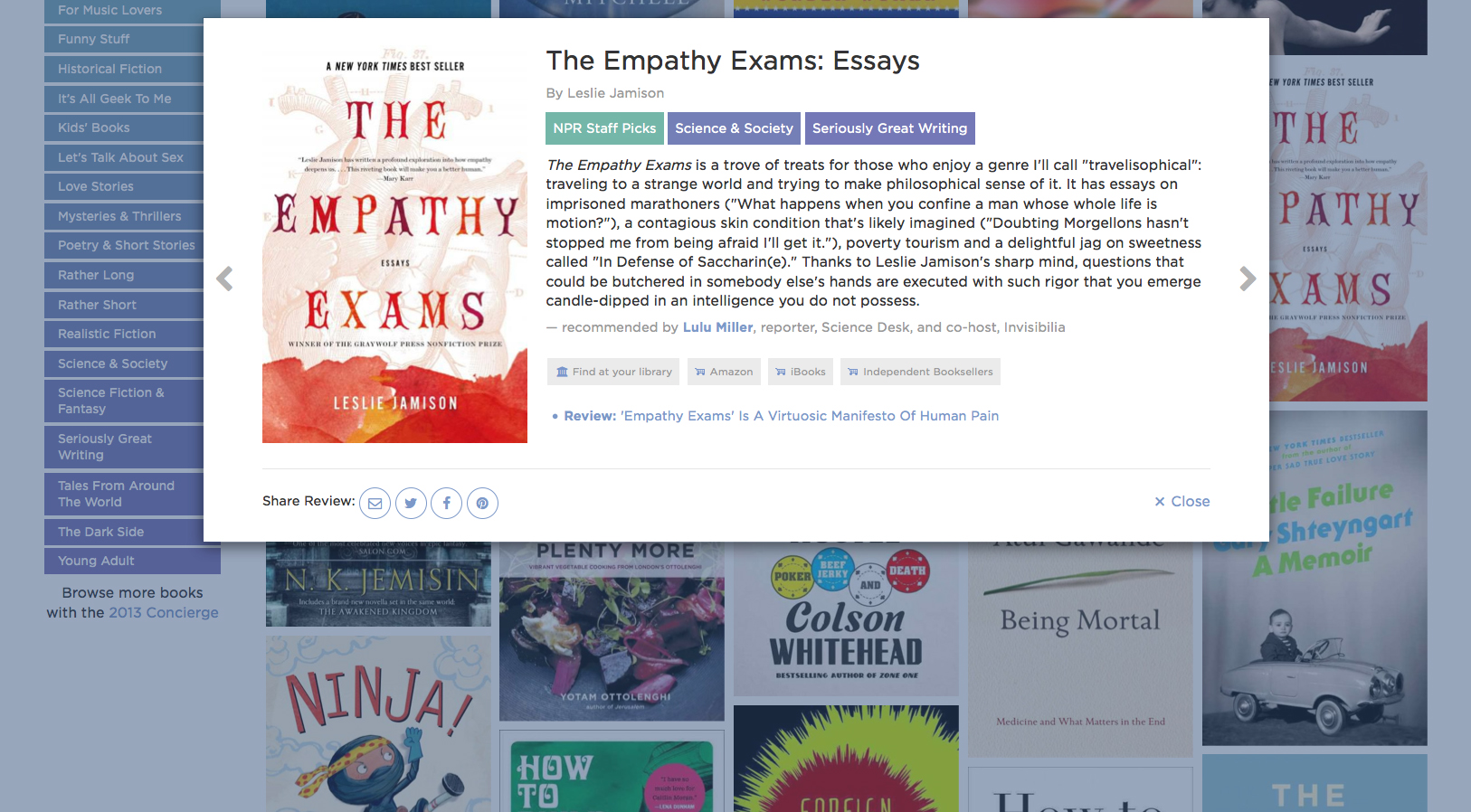
2014
Filter Button Location
In the 2013 concierge the filter button is positioned in the header above the ad on mobile devices, leaving a gap between the button and the book grid. In the 2014 version, we moved the filter button under the ad below the header, grouping the button with the content that it affects. Although the tag usage per viewer on mobile is similar for both years, we thought that this change created a more organized layout.
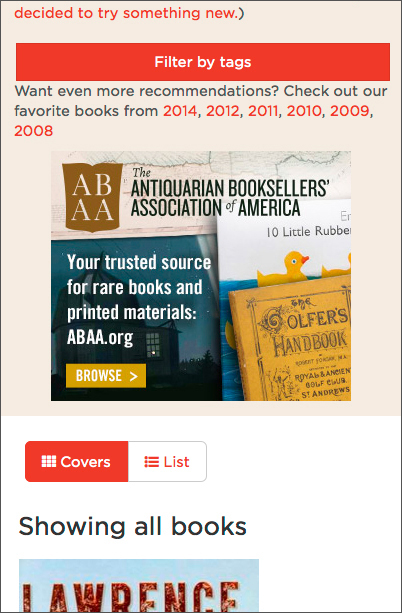
2013
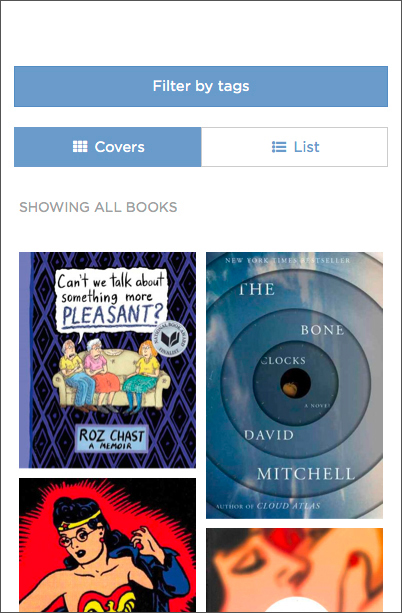
2014
Social Buttons
We wanted to help users share their favorite books and reviews, so we added share buttons to the book modal. In the first 5 days, 6,110 reviews were shared through email, followed by facebook (2,866), pinterest (2,091) and twitter (559).
Links to Previous Years
It would have been cool to combine 2013 and 2014 into one big concierge, but we didn’t have time for that. We still wanted to reference last year’s concierge, as well as book lists from previous years, so we added these links to the header. Additionally, we added a link below the tags list to catch people who skipped past the header. On launch day, the 2013 concierge got 20,330 pageviews driven by the 2014 page.
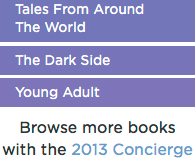
2014
Lighten page load, improve performance
We’ve been able to realize significant performance gains in recent projects by using custom builds of our libraries and assets. We shaved over 300kb off the initial page load by using a custom icon font generated with Fontello rather than including all of Font Awesome. To further lighten the load, we dropped a few unnecessary libraries and consolidated all our scripts into a single file loaded at the bottom of the source.
In 2013 each book had two images, a thumbnail for the homepage and a bigger version for the modal. This year, we cut the thumbnail and aggressively optimized the full-size cover images. The page weight is almost identical, but instead of loading a thumbnail for the cover and a full sized cover when looking at a review, only a single image is loaded. This makes load time feel faster on the homepage, and helps load the reviews faster.
We also disabled CSS transitions at small viewport sizes to improve mobile performance and dropped all CPU intensive 3D CSS transitions.
Responding to users after launch
Finally, some librarians suggested to NPR Books that next year we should include a link to Worldcat, a site that will help you find a book at your local library.

2014
We thought this was a lovely idea and didn’t see why it needed to wait. So we used the Online Computer Library Center identifier API to get the magic book identifier used by Worldcat and added a “find at your library” link the day after launch. This quickly became the second most clicked exterior link after the “amazon” button.
It’s always awesome to make librarians happy.
Nielsen: Milennials DO Listen to Radio
Millennial men are also heavy music listeners. Eighty-eight percent of all Millennial males in the U.S. listen to radio each week, spending more time than their female counterparts tuned in (11 hours and 42 minutes vs. 10 hours and 46 minutes). They also show greater interest in personalized streaming audio services—think Spotify or Pandora—than other demographics.Not surprisingly, they are major digital users:
Millennial males spend less time on average each week consuming traditional TV—only 20 hours, compared to 23 hours for Millennial females, 28 hours for Gen X males and 38 hours for Boomer males. However, they make up much of the difference online. This group spends significantly more time per week (2 hours 15 minutes) than any other demographic watching videos on the Internet
Book Concierge Update
Thompson to Atlantic, Wilson to NY Times
 |
| Matt Thompson |
Total Radio Cume Up, TSL Down
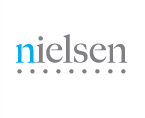 Nielsen's latest Total Audience Report, December 2014 shows that radio cume rose year to year for the 3rd quarter. All Access reports:
Nielsen's latest Total Audience Report, December 2014 shows that radio cume rose year to year for the 3rd quarter. All Access reports:"...radio's overall number of 2+ users was up to 258,734,000 in Q3 2014 versus 257,420,000 in Q3 2013. TSL, however, was down to 58:53 in Q3 2014 from 60:42 in Q3 2013."The report, which mostly discusses TV usage, also shows the same trend among African-American and Hispanic listeners.
"According to the report, this fragmentation doesn't apply just to technology; consumers' viewing and listening habits are following suit. The recent proliferation of new devices allows consumers to connect with content anytime and anywhere. TV is affected the most..."
Baldwin’s Podcast Returns
 |
| Photo: WNYC/Mary Ellen Matthews |
According to All Access, the latest (3rd) season will be released every other Monday. "Guests slated for the new season include JULIANNE MOORE, SARAH JESSICA PARKER, JULIE ANDREWS, and JOHN MCENROE."
Audience 98: Enduring Insights or Now Useless Information?
I encourage you to spend some time with each of these insights. Ask yourself, "Are these lessons stuck in 1998?" "Are they limited to radio only or could they apply to listening via mobile devices and the desktop?" "Could they apply to public radio generated content that people might read on a mobile device or the desktop?" "What new information could make them even more valuable to the decisions public radio leaders face today?"
- People listen to public radio programming because it resonates with their interests, values, and beliefs. This appeal generally cuts across age, sex and race.
- Appeal can also cut across program genres and format types. Different programs and formats may appeal to the same kind of listener as long as they stay focused on that listener’s interests, values, and beliefs.
- Changes in the sound and sensibility of programming can alter its appeal. When programming appeal changes, so does the kind of listener it attracts.
- Listeners send money to public radio when they rely upon its service and consider it important in their lives.
- They are also more inclined to send money when they believe their support is essential and government and institutional funding is minimal.
- Public support, like public service, is the product of two factors: the value listeners place on the programming, and the amount of listening done to the programming.
Is Local News the New Classical Music?
Three interesting code snippets from NPR’s Election Party
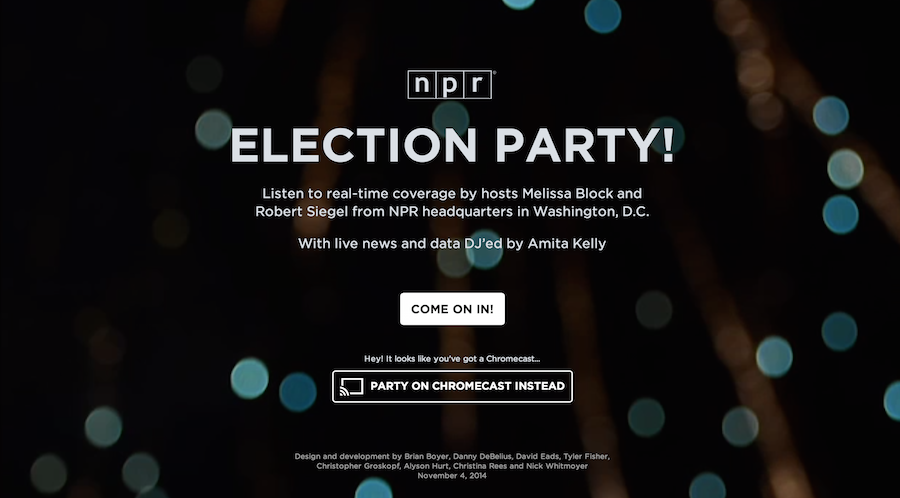
NPR’s Election Party app has a lot of moving parts. It displays live election results from the Associated Press, ingests posts from our Tumblr liveblog, bakes out visualizations of our data, and presents all of this in a slideshow that, on election night, was continuously changing through an admin. It even works as a Chromecast app.
All of the code is open source and freely available to read and use, but it can be hard to make sense of all of it without knowledge of our app template and all the things this app actually does.
There are countless little snippets of this app I could share, but I chose three pieces of the app that would be interesting to share in isolation.
Deploying bug fixes by reloading your users’ browsers
Our app was a static web page, as all of our apps are. We had a server separately parsing AP data, ingesting Tumblr posts and baking out the static website every few minutes, but the client never touched the server. This made it difficult to deploy bug fixes if something broke on election night.
To solve this problem, we devised a simple way to force every client to refresh the web page. We deployed a file with a timestamp to S3, and on page load, the client downloaded that file, read the timestamp and stored it. Then, every three minutes, the client would check that file to see if the timestamp had changed. If the timestamp had changed, the browser refreshed the page. Here’s the client-side code:
var reloadTimestamp = null;
var getTimestamp = function() {
// get the timestamp on page load
if (reloadTimestamp == null) {
checkTimestamp();
}
// continually check the timestamp every three minutes
setInterval(checkTimestamp, 180000);
}
var checkTimestamp = function() {
$.ajax({
'url': '/live-data/timestamp.json',
'cache': false,
'success': function(data) {
var newTime = data['timestamp'];
// if we haven't set a timestamp yet, set it
if (reloadTimestamp == null) {
reloadTimestamp = newTime;
}
// if the initial timestamp doesn't match the new one, refresh
if (reloadTimestamp != newTime) {
// set a cookie in case we need to something to happen
// when the page reloads
$.cookie('reload', true);
window.location.reload(true);
}
}
});
}
$(document).ready(function)() {
getTimestamp();
// stuff you only want to happen if we forced a refresh
if ($.cookie('reload')) {
// for example, skip a welcome screen or hide some UI element
$.removeCookie('reload');
}
});Locally, we could deploy the new timestamp file with a simple Fabric command and deploy function:
#!/usr/bin/env python
from datetime import datetime
import json
from fabric.api import local, task
@task
def reset_browsers():
"""
Create a timestampped JSON file so the client will reset their page.
"""
payload = {}
# get current time and convert to epoch time
now = datetime.now().strftime('%s')
# set everything you want in the json file
payload['timestamp'] = now
with open('www/live-data/timestamp.json', 'w') as f:
json.dump(now, f)
deploy_json('www/live-data/timestamp.json', 'live-data/timestamp.json')
def deploy_json(src, dst):
"""
Deploy to S3. Note the cache headers.
"""
bucket = 'elections.npr.org'
region = 'us-west-2'
sync = 'aws s3 cp %s %s --acl "public-read" --cache-control "max-age=5 no-cache no-store must-revalidate" --region "%s"'
local(sync % (src, 's3://%s/%s' % (bucket, dst), region))We used this once early in the night when we discovered an error with how we were displaying some of our slide types. It worked well, and we could assume all of our users were using the latest versions of our code.
Here is a gist of the described code above.
Widescreen slides on any device
For our app, we decided to optimize for 16x9 or wider devices, which gets you most TVs, laptops, tablets and phones (in landscape mode). Fixing these slides to this aspect ratio and getting everything in the slides to size appropriately was tricky. We used an unusual technique to achieve this.
First, we set the base font size to 1 vw (that is, 1% of the viewport width). Then, we scaled everything else with rem units (like an em unit, but based only on the base font size). By doing this, we were able to accomplish a couple things: We ensured that everything scaled to 16x9 based on the width of the viewport. With some JavaScript, we could also shrink the base font size when the client browser is shorter than 16x9.
A demo of this is simple.
Your HTML file needs only a wrapper div and some content in it:
<div id="stack">
<div class="big">
BIG
<div class="em"></div>
</div>
<div class="little">
little
<div class="em"></div>
</div>
</div>Then, in a CSS file, we set the base font size on the html element to 1vw and ensure there is no margin on the body:
html { font-size: 1vw; }
body { margin: 0; }On the wrapper div, we set a few critical styles to making this work, as well as some styles that make the demo visible:
#stack {
box-sizing:border-box;
-moz-box-sizing:border-box;
-webkit-box-sizing:border-box;
// 16x9 aspect ratio
width: 100rem;
height: 56.25rem;
// centering if the screen is wider than 16x9
margin: 0 auto;
// for the sake of testing
border:4px dashed black;
}In addition, we used rems for all other measurements, including font sizes, widths and heights, so that they would scale appropriately:
.big {
font-size: 10rem;
}
.little {
font-size: 2rem;
}
.em {
background-color: blue;
width: 1rem;
height: .1rem;
}Finally, to make this fully responsive, we need a JavaScript resize function to change the base font size when appropriate:
var onWindowResize = function(){
// get aspect ratio of current window
var aspect = window.innerWidth / window.innerHeight;
/*
* If the window is wider than 16/9, adjust the base font size
* so that the wrapper stays 16/9, and letterboxes
* to the center of the screen.
*/
if ( aspect > 16/9) {
document.documentElement.style.fontSize = ((16/9) / aspect) + 'vw';
} else {
document.documentElement.style.fontSize = '1vw';
}
}This, of course, required prompting users to shift their phones and tablets into landscape mode.
If you want to see this demo in action, see it on Codepen and resize your browser a bunch. In addition, here is a gist of all the code.
Developing Chromecast applications in JavaScript
The functionality we desired for Chromecast users went beyond simple tab mirroring, which Chromecast allows you do to with any website. Instead, we wanted to make your casting device a remote control, able to mute audio and navigate between slides. To do so, we had to use the Google Cast SDK. The Cast SDK allows you to make the Chromecast load your app on an internal version of Chrome installed on the hardware.
The SDK works pretty well, and other people have done good work in documenting how to get a Chromecast app set up. Peter Janak, in particular wrote a Chromecast Hello World application that was very helpful for us.
To make our lives easier, we wrote a simple library to handle initializing Chromecast sessions and passing messages between the connected device and the Chromecast. Next time we develop a Chromecast app, we will probably develop this further into a standalone library, but it works well as is now.
In addition to embedding the SDK JavaScript on your site, we have two files, chromecast_sender.js and chromecast_receiver.js. Read the full source here. These files provide a friendlier API for interacting with the Chromecast. Specifically, they define the CHROMECAST_SENDER and CHROMECAST_RECEIVER objects, which allow you to interact with casting devices and Chromecasts in code.
First, to setup a Chromecast app, you need to check if a user has the Chromecast extension installed:
// define some global vars
var IS_CAST_RECEIVER = (window.location.search.indexOf('chromecast') >= 0);
// is a currently casting device
var is_casting = false;
window['__onGCastApiAvailable'] = function(loaded, errorInfo) {
// We need the DOM here, so don't fire until it's ready.
$(function() {
// Don't init sender if in receiver mode
if (IS_CAST_RECEIVER) {
return;
}
// init sender and setup callback functions
CHROMECAST_SENDER.setup(onCastReady, onCastStarted, onCastStopped);
});
}An important thing to keep in mind is that, in our model, the Chromecast app actually runs the same code as the client. You need to maintain state across your app so that your code knows whether the client is a Chromecast or a regular web browser. Thus, you would have a function for the sender when a Chromecast session is initiated, and a code path in your ready function for Chromecasts specifically:
// function for casting devices
var onCastStarted = function() {
is_casting = true;
// show what you want to appear on the casting device here
$chromecastScreen.show();
$castStart.hide();
$castStop.show();
}
// example code path when the document is ready
$(document).ready(function() {
if (IS_CAST_RECEIVER) {
CHROMECAST_RECEIVER.setup();
// Set up event listeners here
CHROMECAST_RECEIVER.onMessage('mute', onCastReceiverMute);
}
});Note that you can set event listeners on the Chromecast. This allows you to send messages between the casting device and Chromecast, which powered our remote control functionality. Here’s an example message sending function and receiver callback that allowed us to mute the audio on the TV from the casting device:
/*
* Cast receiver mute
*/
var onCastReceiverMute = function(message) {
if (message == 'true') {
$audioPlayer.jPlayer('pause');
} else {
$audioPlayer.jPlayer('play');
}
}
/*
* Unmute the audio.
*/
var onAudioPlayClick = function(e) {
e.preventDefault();
if (is_casting) {
CHROMECAST_SENDER.sendMessage('mute', 'false');
} else {
$audioPlayer.jPlayer('play');
}
$audioPlay.hide();
$audioPause.show();
}
/*
* Mute the audio.
*/
var onAudioPauseClick = function(e) {
e.preventDefault();
if (is_casting) {
CHROMECAST_SENDER.sendMessage('mute', 'true');
} else {
$audioPlayer.jPlayer('pause');
}
$audioPause.hide();
$audioPlay.show();
}Importantly, we were able to handle both casting devices and one-screen sessions in the same code path thanks to our state variables.
Again, read the full source of our Chromecast code in this gist.
The many moving parts of our elections app created more interesting pieces of code, and you can dig through everything in our repo. As always, the code is open source and free to use.
Hoban, Abramovitz to Fill PRPD Board Positions
 |
| Matt Abramovitz |
 |
| Jon Hoban |
A complete PRPD Board listing is located at http://www.prpd.org/aboutus/board.aspx
Note: The next PRPD Board Election is coming up soon. Nominations will begin in December.
Greater Public Announces New Board Leadership
The Story Behind the Geezer Grants
Posted To: Ideas & Innovation > Blogically Thinking
Masters Mediapreneurs and the J-Lab were featured in three MediaShift articles: J-Lab’s Jan Schaffer Reflects Back on 20 Years of Journalism Innovation; J-Lab Launches Journalism Grant Program for Baby Boomers; and Reimagining Journalism School as a ‘Gateway Degree’ to Anything
Last week we announced an awards project to help Baby Boomers launch news startups. This week, we chuckle at our new nickname and shine a spotlight on the history that gave the project momentum.
"Geezer grants" is the term some wags have applied to the $12,000 startup funding open to people age 50-plus who want to launch a news project. Bring it on. Fourteen applications have been submitted for the four awards in the first week. The deadline is Dec. 15.
The funding will come as an award, not a grant. That means individuals are eligible; you don't have to be a nonprofit organization. You can preview the application here and fill one out here.
When J-Lab started raising money for the Encore Media Entrepreneurs project, I already knew this cohort group was keenly interested in responsible news and information, were digitally savvy, and had an appetite for launching news startups.
At least 17 of the start-ups J-Lab has funded since 2005 were the vision of adults aged 53 to 70. And they rank among our most enduring projects. They have been winners of seed funding from J-Lab's New Voices program and from our New Media Women Entrepreneurs program.
They are people like former magazine publisher Ken Martin, who launched The Austin Bulldog in Texas in 2009 at age 70. He has since pugnaciously covered local government, filing 156 FOIA requests just since January 2011.
His stories have led to more open meetings and open records, including a requirement that Austin City Council members must use city email accounts, not personal emails, to conduct city business.
Meet some others:
- Professor Chris Harper, at 57, launched PhiladelphiaNeighborhoods.com in 2009 and it has since become part of the capstone for Temple University's journalism program.
- Non-profit executive Sharon Litwin, 69, launched NolaVie.com with journalist Renee Peck, 56, in 2010 in New Orleans. The arts and culture news site has since forged a content partnership with WWNO, the city's public radio station.
- Environmental journalist Dave Poulson, at 53, launched Great LakesEcho in 2009 to cover environmental issues and his portfolio continues to grow. It is a spinoff from the 2006 Great Lake Wiki.
- Former San Jose Mercury News journalist Janice Rombeck, at 59, started NeighborWebSJ in 2010 to cover neighborhood issues San Jose, CA.
- Former Oregonian art critic Barry Johnson launched Oregon Arts Watch in Portland in 2010 at age 59.
- One-time Yahoo exec Susan Mernit, at 53, launched Oakland Local to focus on social justice issues in Oakland, CA. in 2009.
- Professor Lew Friedland was 54 when he launched Madison Commons community news site in Wisconsin in 2005.

J-Lab's list doesn't stop there, nor does the variety.
Take a look at what Laura Fraser, Peggy Northrop and Rachel Greenfield are doing with Shebooks.net. What Jeanne Pinder is doing with ClearHealthCosts.com. What Michele Kayal, Bonny Wolf, Carol Guensburg and Domenica Marchetti are doing with AmericanFoodRoots.com, which just won two 2014 awards from the Association of Food Journalists: best food blog and best non-newspaper food feature. The possibilities are stimulating.
All of these projects launched with micro funding of between $12,000 and $25,000.
Here's an observation from Maureen Mann, who was a retired school teacher when she won J-Lab funding to start The Forum in Deerfield, N.H. in 2005 at age 59: "One thing to point out is that people over 50 are used to having access to good media, want good media and have the time to make it happen – often for a lot less money (or in some cases no money but a desire for a good source of news)."

'The Forum has since expanded coverage to three other New Hampshire communities and Mann has been a mentor to former PTA volunteer Christine Yeres as she started NewCastleNOW.org to cover Chappaqua, N.Y.
Of note, our media entrepreneurs seem to align with Kauffman Foundation research that finds adults in the 55-64 age group have a high rate of entrepreneurial activity, comprising 23.4 percent of all us entrepreneurs in the U.S. – up from 18.7 percent in 2003.
A MetLife Foundation survey found that two out of three want to have local or regional, not national, impact. Two out of three potential encore entrepreneurs said they'd find their business worthwhile if they made less than $60,000 a year. About the same percentage said they need $50,000 or less to get started, and many expect to tap personal savings. Those are realistic numbers for local news startups.
More information on the Encore Media Entrepreneur Awards
Four $12,000 awards are available to those Baby Boomers who have a vision for a news venture and a plan to continue it after initial funding is spent. Funding can be used for web sites, mobile apps or other news ideas. The deadline for proposals is Dec. 15, 2014. See guidelines here. Apply online here: https://www.surveymonkey.com/s/EncoreEntrepreneurs.
The awards are supported with funding from the Ethics and Excellence in Journalism Foundation and the Nicholas B. Ottaway Foundation.
Sample clocks for fundraising with the new Morning Edition
It may be shocking to realize that the new newsmagazine clocks for NPR start on Monday. While many stations are busy planning their regular schedules with the new clock, it won't be long before you'll have to figure out your fundraising clock with the new format.
Since Morning Edition is the most changed of the clocks, Greater Public's Jay Clayton put together a few sample approaches for how you can pitch during Morning Edition after the clock change. Both of these examples try to get 20 minutes of pitching an hour spread out into four breaks. You can use these as you create your own fundraising clocks for Morning Edition.
Here are the two examples:
FOR STATIONS THAT DON'T TIME-SHIFT
NPR news 01-04
Station news 04-7:30
NPR A seg 07:30-12
Pitch 1 12-19
Newscast 19-20:30
Station news 20:30-22:50
NPR B seg 22:50-27
Pitch 2 27-33:35
NPR C seg 33:35-41
Pitch 3 41-45:35
NPR D seg 45:35-49:35
Funders 49:35-51
NPR E seg 51-55
Pitch 4 55-01
FOR STATIONS THAT DO TIME SHIFT
NPR news 01-04
Station news 04-06
Pitch 1 06-12
NPR A Seg 12-23:30
Pitch 2 23:30-30
NPR B Seg 30-37:10
Pitch 3 37:10-43
NPR C/D segs 43-54:30
Pitch 4 54:30-01
AIR to Expand Localore Projects
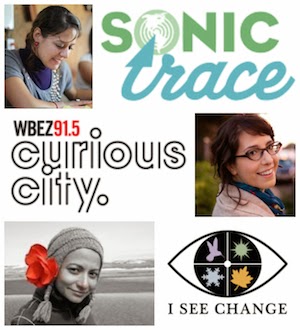 The Association of Independents in Radio (AIR) has received funding to expand three of its Localore projects - Curious City, iSeeChange and Sonic Trace. The funding will allow producers of those projects (located at Chicago Public Media, KVNF, Paonia and KCRW, LA.)
The Association of Independents in Radio (AIR) has received funding to expand three of its Localore projects - Curious City, iSeeChange and Sonic Trace. The funding will allow producers of those projects (located at Chicago Public Media, KVNF, Paonia and KCRW, LA.)With the grant from the Wyncote Foundation, AIR has established a "...New Enterprise Fund, a grant distribution that will spread new models and best practices from three Localore productions to stations and producers across the public media system."
Joyce Mac to CPB
"In this role, Joyce will be able to amplify what she has done so exceptionally for so many years, advocate for the critically important work of local journalism throughout the system and across all platforms."MacDonald is also quoted:
“I am very grateful for the unique opportunity NPR has given me to be on the front lines of delivering on our mission to provide high quality national and local public service journalism. I look forward to continuing this important work on behalf of the American public at CPB.”Joyce worked for many years in NPR station relations and recently spent 2 years as Chief of Staff under Gary Knell. In the past year has been Interim President and CEO for NPM.
According to a CPB release, MacDonald will start at CPB next Monday, Novembber 10.
Jody Evans Named Next PRPD Prez
Car Talk’s Tom Magliozzi Dead at 77
Twenty Years on the Front Lines of Journalism Innovation
Posted To: Ideas & Innovation > Blogically Thinking
J-Lab director Jan Schaffer is wrapping up 20 years of raising money to give it away to fund news startups, innovations and pilot projects. She is pivoting J-Lab to do more writing, custom training and discrete projects.
After two decades of work at the forefront of journalism innovations, interactive journalism and news startups, she weighs in with some observations and lessons learned. This post addresses journalism innovations.
Little did I expect when I left The Philadelphia Inquirer to come to Washington, D.C., 20 years ago, that I would end up on the frontlines of journalism innovation, participatory journalism and news startups – just as the journalism industry was on the precipice of profound disruption.
I quickly took on a leadership role in what was to become one of the nation's most controversial attempts to reform journalism: the civic journalism movement. Castigated by the cardinals of the profession for its outreach to readers and viewers (there weren't many "users" then), civic journalism was an effort to experiment with new ways to engage audiences and stimulate citizen involvement in elections, local issues and problem solving. Its critics found abhorrent any idea that citizens might have input into how journalists did their jobs.
I can look back now with some amusement. But I gotta say: Civic journalism really worked. (More on this in another blog post.) It makes most of today's audience engagement initiatives look a mile wide and an inch deep.
I now see the degree to which civic journalism was a precursor to today's participatory and interactive journalism and the rise of citizen journalists. And I am heartened when I see so many entrepreneurial news startups openly embrace civic aspirations. Consider Jim Brady's BillyPenn.com, for one.
When a decade of the Pew Charitable Trusts' generous support for civic journalism ended, I spun our efforts into J-Lab: The Institute for Interactive Journalism. Informed by early clickable maps that served as surrogate public hearings (kudos to the Everett Herald's Waterfront Renaissance project) and by the gaming instincts of the first state tax calculators and budget balancers (hat tips to New Hampshire and Minnesota Public Radio), I wanted to move in a more digital direction. It was 2002, and we soon found ourselves in the vanguard of an onslaught of activities. We rewarded innovations with theKnight-Batten Awards, seeded startups with theNew Voices projects and Women Entrepreneur awards, built digital capacity and created new kinds of knowledge.
J-Lab became a catalyst for news ideas that work. The center and its advisory boards funded 100 news startups and pilot projects. They included community news startups, women media entrepreneur initiatives, networked journalism initiatives and enterprise reporting awards.
In the process of monitoring these projects, J-Lab learned a lot. And we shared it in 11 publications and five websites that have been used as resources in newsrooms and classrooms. J-Lab was the first to chronicle the emergence of citizen-ledcommunity news sites. It was the first to capture the extent of nonprofit funding for news projects with a 2009 database of grant-funded news projects accompanied by video case studies. We tapped Mark Briggs to write "Journalism 2.0," and it was such a popular early guide to digital literacy, it was downloaded some 200,000 times.
As I pivot to embrace some new projects, I offer this roundup of some lessons learned:
- Innovations awards work - if they recognize more than multimedia bells and whistles. Audience engagement and impact are the most useful barometers of excellence.
- Micro-grants for startups work - when the founders are genuinely committed to leveraging a proof of concept into an ongoing project.
- News entrepreneurs see new jobs to be done in today's media space – but far too many are leaving traditional newsrooms to do them.
- You can change behaviors by incentivizing change - if you set out short-term and long-term expectations.
Entrepreneurship
Our funding for news startups ranged from $10,000 to $25,000 per project, and our pilot-projects ventures received $5,000 to $50,000. The demand for micro start-up awards is enormous and the success rate is notable, especially when applicants must lay out plans for sustainability.
We received 2,011 applications for 22 awards in our McCormick New Media Women Entrepreneur initiative, launched in 2008; 73 percent of those projects are still active. Across the board, the applicants were deeply accomplished, with many Pulitzer, Peabody and Fulbright winners in the mix. The vast majority of the proposals expressed a passion for purpose-driven news and information projects addressing such things as sustainability, social justice or equity. These themes have started to become more pronounced in recent years. Look at The Marshall Project as a case in point.
The vast majority of our women entrepreneurs were also refugees from traditional newsrooms. What a shame their ideas could not find the oxygen to be developed in-house.
Our New Voices grants for community news startups attracted 1,433 proposals for 55 projects that turned into 57 websites. However, 44 percent of the projects were launched by journalism schools and half of these could not figure out how to continue after the initial funding was spent. Kudos, though, to some notable exceptions: Chicago Talks, Great Lakes Echo,Philadelphia Neighborhoods, Madison Commons and Intersections South LA.
I am particularly proud that our award winners represented a broad cross-section of applicants who won on the merits of their ideas and not because they had past relationships or grant-writing abilities.
Training
J-Lab's shared its learning in dozens of high-touch training programs for both journalism practitioners and educators at national journalism gatherings and at our own interactive summits and workshops. For more than 10 years J-Lab programmed lunches for journalism educators at AEJMC. For eight years, we produced sold-out pre-convention workshops for the Online News Association. We convened the first summit of university-based news sites and two women media entrepreneur summits. When you give people practical, accessible tools and information, they will use them.
Our Knight Community News Network suite of consultants engaged partners to provide learning modules on how to become a nonprofit 501(c)3, avoid legal risks, use social media and engage audiences. Our J-Learning site offers tutorials in using publishing software and hardware.
Innovations Awards
For nine years, J-Lab and its advisory board rewarded first-mover innovations via the Knight-Batten Awards for Innovations in Journalism. We honored 56 winners and showcased 196 notable entries, good ideas even if they didn't win. Again and again, our awards were an early scout for innovations that later turned into Knight News Challenge winners or Knight grantees. Many of the ideas also were replicated by other news organizations.
While we may not know exactly where we are going in the future, sometimes, it's helpful to look back. I am struck by how, if you track past Knight-Batten winners, you really capture the arc of journalism's reinvention over the last decade. The awards were among the first to validate and honor:
- News games with Minnesota Public Radio's state Budget Balancer (2003).
- Participatory journalism with KQED's "You Decide" exercise tool and early crowdsourcing with USAToday giving readers the chance to pick their winners in West Virginia's NewSong Festival for songwriters (2004).
- Database journalism with the Grand Prize going to ChicagoCrime.com, a searchable database of local crime that later became EveryBlock. Minnesota Public Radio was honored for Public Insight Journalism participatory journalism efforts that have since been adopted around the country (2005).
- Blogs , with the still-robust Global Voices winning for curating and translating international blogs. Our first social media award went to the Bakersfield Californian. The theme of journalistic transparency emerged with webcast news meetings of the Spokane's Spokesman-Review (2006).
- Non-traditional journalism winners: the Personal Democracy Forum for its techpresident.com initiative and the Council on Foreign Relations for its Crisis Guides. It was time to acknowledge how new players were entering the news and information space. Our first citizen media award went to The Forum, the nine-year-old citizen-run hyperlocal site for Deerfield, N.H. (2007)
- Fact-checking was the theme with Wired.com's Wikiscanner winning for developing a way to truth-squad entries on Wikipedia. PolitiFact won for fact-checking public officials and candidates. Ushahidi showed us how mobile phone crowdsourcing could help with crisis information (2008).
- Innovations in mainstream media had the New York Times sweeping the awards with aportfolio of innovative entries. The rise of nonprofit journalism channeled honors to the Center for Public Integrity (2009).
- Transparency was the theme of Grand Prize winner The Sunlight Foundation's Sunlight Live coverage of the health care summit with an innovative blending of data, liveblogging, streaming video and social media. An award to ProPublica's distributed reporting corps paid tribute to the theme of collaboration (2010).
- Social media was the hallmark of the final year of the awards, 2011, which honored Storify's social media story builder and NPR's Andy Carvin for his Twitter coverage of the Arab Spring.
The Knight-Batten Awards were unique in their focus on innovations that "spurred non-traditional interactions," demonstrably engaged audiences, "employed new definitions of news" and "created news ways of imparting useful information." Again and again, they proved to be remarkably prescient about innovations that would have real staying power.
My thanks to our supporters, who had the courage and creativity to fund these activities, including The Pew Charitable Trusts and the Knight, McCormick, Ethics and Excellence, Ford, Wyncote, William Penn, Gannett and Ottaway Foundations and to American University, our home.
Journalism Education: It’s Time to Craft the Gateway Degree
Posted To: Ideas & Innovation > Blogically Thinking
J-Lab director Jan Schaffer is wrapping up 20 years of raising money to give it away to fund news startups, innovations and pilot projects. She is pivoting J-Lab to do more consulting, custom training and discrete projects.
After two decades of work at the forefront of journalism innovations, interactive journalism and news startups, she weighs in with some observations and lessons learned. This post addresses journalism education.
If I were to lead a journalism school today, I'd want its mission to be: We make the media we need for the world we want.
Not: We are an assembly line for journalism wannabes.
The media we need could encompass investigative journalism, restorative narratives , soft-advocacy journalism , knowledge-based journalism,artisanal journalism, solutions journalism, civic journalism, entrepreneurial journalism, explanatory journalism, and maybe a little activist journalism to boot. That's in addition to the what-happened-today and accountability journalism.
Journalism is changing all around us. It's no longer the one-size-fits-all conventions and rules I grew up with. Not what I was taught at Northwestern's Medill School of Journalism. Not what I practiced for 20 years at The Philadelphia Inquirer.
Yet, as someone who consumes a lot of media, I find I like journalism that has some transparent civic impulses, some sensibilities about possible solutions, and some acknowledged aspirations toward the public good. Even though I realize that might make some traditional journalists squirm.
And I'd assert that – if the journalism industry really wants to engage its audiences and woo new ones, and if the academy wants its journalism schools to flourish – it's time for journalism schools to embrace a larger mission and to construct a different narrative about the merits of a journalism education.
It's time for journalism schools to embrace a larger mission and to construct a different narrative about the merits of a journalism education.
There is some urgency here. Colleges and universities are cascading toward the disruptive chaos that has upended legacy news outlets. Many, like newspapers, will likely shut their doors in the next decade or two, victims of skyrocketing tuitions, unmanageable debt, unimaginative responses and questionable usefulness.
Adding to the urgency are indications that some J-school enrollments have declined in the last few years, according to the University of Georgia's latest enrollment survey, released in July. Industry retrenchment is partly blamed for making prospective students and their parents nervous about future jobs.
How do you quell that nervousness? One way is to articulate a new value proposition for journalism education; next, of course, is to implement it.
It's time to think about trumpeting a journalism degree as the ultimate Gateway Degree, one that can get you a job just about anywhere, except perhaps the International Space Station.
It's time to think about trumpeting a journalism degree as the ultimate Gateway Degree, one that can get you a job just about anywhere, except perhaps the International Space Station.
Sure, you might land at your local news outlet. But, armed with a journalism degree, infused with liberal arts courses and overlaid with digital media skills, you are also attractive to information startups, nonprofits, the diplomatic corps, commercial enterprises, the political arena and tech giants seeking to build out journalism portfolios, among others.
We already know that a journalism education – leavened with liberal arts courses and sharpened with interviewing, research, writing, and digital production/social media competencies– is an excellent gateway to law school or an MBA. And we already know that journalism education has moved away from primarily teaching students how to be journalists; indeed, seven out of 10 journalism and mass communications students are studying advertising and public relations, according to the UGA study.
In particular, schools that offer students hands-on experience running real newsrooms, a piece of the "teaching hospital" model of journalism education, pave the road to richer, more varied futures.
Refining the Gateway Degree, however, means embracing different types of journalism and showcasing different definitions of success achieved by alums, not just highlighting those who work in news organizations.
Journalism education as a Gateway Degree is a good business proposition – both for the journalism schools and for the industry. We need journalism schools to teach more than inverted-pyramid stories and video and digital production, in part because the industry is awash in entrepreneurial startups that are practicing excellent journalism but are increasingly mission-driven. They are driving strong coverage of public schools, public health, diverse communities and sustainable cities. Moreover, the news startup space is increasingly populated by nonprofit, regional investigative news sites.
For many startup founders, it's not enough to afflict the comfortable or speak truth to power. They want their journalism to solve problems, improve lives and help make things better. These startups want measureable impact...
For many of these startup founders, it's not enough to afflict the comfortable or speak truth to power. They want their journalism to solve problems, improve lives and help make things better. These startups want measureable impact beyond winning a journalism prize or changing legislation. This is a mindset, however, not a skill set, and one not often addressed in a standard journalism curriculum.
Instead, journalism schools in recent years have been hyper-focused on skill sets – convergence in the last decade, and coding and data skills in this one.
Media entrepreneurship courses especially can help pave the way for embracing a broader mission and cultivating different mindsets. Courses in entrepreneurial journalism train students to spot what disruption guru Clay Christensen calls "jobs [that need] to be done" and rethink how to engage audiences in those challenges. Students do competitive scans (a good exercise for solutions reporting); they construct business plans (a useful reality exercise); and they build wireframes, proof-of-concept sites or apps (an introduction to the maker culture).
These activities also help channel those students who come to journalism school thinking they are going to produce works of art – the "I like to write" students – into more grounded activities.
Equally important, though, is the role that journalism education can play in the aspirations and social mindsets of Millennials, who are now wearing two hats: as news consumers and news creators. "One of the characteristics of Millennials, besides the fact that they are masters of digital communication, is that they are primed to do well by doing good. Almost 70 percent say that giving back and being civically engaged are their highest priorities," Leigh Buchanon writes in Meet the Millennials.
There is more work to be done in rendering how responsible journalism meshes with responsible aspirations to advance the public good. But the ripple effect of engaging audiences in issues people care about can be enormous if news organizations master the onramps.
So I'd say it's time to be creative in leveraging current abilities and new mindsets to design a robust Gateway Degree that can imagine and deliver upon the media we need for the future.
Clock Tips From NPR
1. Download and review the new clocks- Clocks are available for all NPR shows at NPRstations.org.
You'll also find more resources there, including FAQs and sample audio of how ME and ATC
will sound with the new clocks. Information on that page is valuable to local hosts, engineers,
traffic coordinators, etc.
2. Subscribe to the new newsmagazine evergreens- New evergreens are coming for all NPR shows.
For the newsmagazines, there are new Content Depot program subscriptions and you'll need to
subscribe in order for them to download automatically. For the other NPR programs, you will
find the new evergreens at their respective general program pages. All evergreens will be in
place by November 17.
3. Subscribe to the new funding credit feeds- If your station makes use of the NPR-voiced
funding credits available from Content Depot, you will need to subscribe to the new feeds.
There are also changes coming to the break names for the newscast credits.
Encore Media Entrepreneurs Invited to Apply for Four $12,000 Startup Grants
Posted To: Press Releases
Washington, D.C. - Encore media entrepreneurs, age 50+, are invited to apply for seed funding to help them launch news projects in 2015 as part of a new initiative launched today by J-Lab: The Institute for Interactive Journalism.
Four $12,000 awards are available to those Baby Boomers who have a vision for a news venture and a plan to continue it after initial funding is spent. The awards are supported with funding from the Ethics and Excellence in Journalism Foundation and the Nicholas B. Ottaway Foundation.
Funding is available for web sites, mobile apps or other news ideas. The deadline for proposals is Dec. 15, 2014. See guidelines here. Apply online here: https://www.surveymonkey.com/s/EncoreEntrepreneurs.
"We are seeking to create replicable models for engaging older adults in digital leadership roles in democratic society – roles that can help watchdog local officials, foster doable solutions to community problems, and build models for civic participation through the media, not just the voting booth," said J-Lab Director Jan Schaffer.
"This cohort group, raised in the journalism of the Watergate-era, seem eager to participate in their communities in new digital ways," she said.
J-Lab has provided seed funding to 100 start-ups and collaborative pilot projects since 2005. "At least 17 of the 100 start-ups we have funded so far were the vision of adults aged 53 to 70. They have been among our most enduring projects," Schaffer said. See some of those projects here: http://www.j-lab.org/projects/masters-mediapreneurs-initiative/
These site founders were familiar with new digital tools, Schaffer said. Often, they were empty nesters who had been involved in their community. Some were journalists who took left newsrooms in the downsizings that have swept the news industry since 2007. Others are embracing an encore career – or just an encore hobby.
Here's an observation from Maureen Mann, a retired school teacher who founded The Forum in Deerfield, N.H. in 2005 at age 59: "One thing to point out is that people over 50 are used to having access to good media, want good media and have the time to make it happen – often for a lot less money (or in some cases no money but a desire for a good source of news)."
Encore media entrepreneurs align with research from the MetLife Foundation that finds adults in the 55-64 age group have the highest rate of entrepreneurial activity in the U.S. Two out of three:
- Want to have local or regional, not national, impact.
- Say they'd find their business worthwhile if they made less than $60,000 a year, which is in line with sustainable models for media start-ups.
- Say they need less that $50,000 to get started. Nearly one-half expect to tap personal savings to launch ventures.
J-Lab, founded in 2002, is a journalism catalyst. It funds new approaches to news and information, researches what works and shares practical insights with traditional and entrepreneurial news organizations. Jan Schaffer is Entrepreneur in Residence at American University.
Bannon Named PRPD Secretary
Bannon is Vice President of Content Development and Production at WNYC. From 2006 through 2012, he served as Program Director for WNYC AM and FM. During that time, he also led the teams that launched WQXR and New Jersey Public Radio. In addition to leading the development of new content for WNYC's platforms, he oversees The Leonard Lopate Show, Soundcheck, Studio 360, Freakonomics Radio, Here's The Thing, and collaborations with other broadcast partners. Prior to joining WNYC he worked on a variety of national radio shows, including Here and Now, Michael Feldman's Whad'Ya Know? and A Prairie Home Companion with Garrison Keillor.
Gomeshi and CBC Split

"The CBC is saddened to announce its relationship with Jian Ghomeshi has come to an end, This decision was not made without serious deliberation and careful consideration. Jian has made an immense contribution to the CBC and we wish him well"According to the Globe and Mail, Gomeshi will file a $50 million suit when courts open on Monday.
UPDATE: KPCC reports on underlying issues.
1-0/28/14: Jian Gomeshi Facebook post
Apply NOW for a spring internship with NPR Visuals
Hey!
Are you a student?
Do you design? Develop? Love the web?
…or…
Do you make pictures? Want to learn to be a great photo editor?
If so, we’d very much like to hear from you. You’ll spend the spring working on the visuals team here at NPR’s headquarters in Washington, DC. We’re a small group of photographers, videographers, photo editors, developers, designers and reporters in the NPR newsroom who work on visual stuff for npr.org. Our work varies widely, check it out here.
Photo editing
Our photo editing intern will work with our digital news team to edit photos for npr.org. It’ll be awesome. There will also be opportunities to research and pitch original work.
Please…
- Love to write, edit and research
- Be awesome at making pictures
Are you awesome? Apply now!
News applications
Our news apps intern will be working as a designer or developer on projects and daily graphics for npr.org. It’ll be awesome.
Please…
- Show your work. If you don’t have an online portfolio, github account, or other evidence of your work, we won’t call you.
- Code or design. We’re not the radio people. We don’t do social media. We make stuff.
Are you awesome? Apply now!
What will I be paid? What are the dates?
The deadline for applications is November 21, 2014.
Check out our careers site for much more info.
Thx!
Adobe & Nielsen to Launch Digital Content Ratings
The company’s long-awaited Digital Audio Measurement product will be rolled into the new more comprehensive digital service. “To be clear, Digital Content Ratings is not replacing or changing our Digital Audio Measurement plans,” a Nielsen rep tells Inside Radio. “The new audio service will be a component of the larger, comprehensive product that is Digital Content Ratings.” Incorporating streaming audio, from both broadcasters and pureplay streamers, into an all-encompassing digital ratings service may help elevate the medium in the eyes of the large ad agency holding groups that have already expressed support for Digital Content Ratings, including IPG Mediabrands and Starcom MediaVest Group
Working on fundraising breaks and the new clocks? Greater Public’s Jay Clayton has some tips.
Morning Edition: | 2 hours 11 minutes* |
All Things Considered: | 1 hour 25 minutes* |
Weekend All Things Considered: | 37 minutes* |


